
ONTARIO

Crystal Beach
NO PART OF THE FOLLOWING
ARTICLE AND PHOTOGRAPHS
MAY BE REPRODUCED WITHOUT
PERMISSION FROM THE AUTHOR ©
Crystal Beach began as a Chautauqua show area, or religious campground in 1888, much the same as Grimsby Park had several decades earlier. Crystal Beach was about 60 kilometres southeast of Grimsby, and for the campground at Crystal an auditorium, tents, and picnic grounds were provided. It proved popular enough to draw 150,000 per season. Entrepreneurs saw an opportunity to make money from this by having side show performances between sermons, and to offer refreshments.
This was not lost on a group of investors; they got together in 1890 and formed The Crystal Beach Company, as it was dubbed by one of the partners because of the sand quality there. The beach area was a major attraction because of a gentle slope that ran for some distance underwater with no drop-offs or undertow.
The investors installed amusements, built a pier and started ferry service to the park which landed its first customers on July 16th of that year. They had actually tried four days earlier, but the side paddle wheels of The Dove did not allow it to dock properly. It took those four days to make modifications (presumably to the dock) before patrons could visit the park. To house guests, investors built The Assembly House Hotel which was later renamed The "Royal". It lasted until 1923 when it burned down.
The ferry company ran The Dove (500 passenger) and Superior (1200 passenger), for the 1890 season, but bought Pearl (800 passenger, later renamed Crystal) in 1891 to meet the demand as more Americans began to visit the Canadian park. Other ferries to make the run in the park's first decade were Gazelle, Puritan (launched 1982), Pilgrim, State of New York, A.J. Timon, Garden City and Darius Cole. The Puritan would unfortunately burn in Buffalo in 1901.
In 1896, The Ontario Southern Railroad decided to compete with the ferries and ran an electric rail service from Ridgeway to Crystal Beach, a distance of about 2 and a half kilometres. It consisted of a center running rail between two guide rails mounted on posts 3 to 9 metres above the ground and thus got the nicknames of the "Peg-Leg" and "Bicycle Railway".
At first, power was supplied by battery, but in 1898, a conventional trolley pole was used to supply power. Research by Brian Westhouse of Rexdale, Ontario shows: "Power was supplied by an 8 horsepower steam engine, which in turn ran a 5 kilowatt generator. That furnished power for a 5 horsepower electric motor installed in the motor car. The engine, or motor car hauled one coach which had a seating capacity for about 20 passengers."
"The engine and coach alike were built on the bicycle principle, running on one rail with the trolley wire beneath it. The rail was laid on a trestle of 20 x 20 centimetre timbers, ranging in height from 1.25 to 14 metres above the ground. Top speed was approximately 40 kilometres per hour. The dispatching was ultra-modern for the time with a complete telephone service comprising two phones, one at each end of the road. In one place, the train actually ran through a tunnel about midway along the route, a short distance from the present Ridgeway cemetery."
|
Peg-Leg Railway 1896 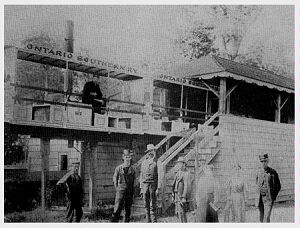
|
Here is a view of the Ontario Southern Railroad. A train is seen on the trestle, with the station at the right. Note what appears to be a smoke stack or power pole to your left of the train conductor. If it is a smokestack, this photo may be misdated, or the introduction of generated power occurred before 1898. |
Brian continues: "The Ontario Southern Railway was incorporated within the charter for Crystal Beach Amusement Park in 1897. The purpose of the railway was to convey passengers to the Park from Ridgeway, where a connection was made with the Grand Trunk trains from Fort Erie and Buffalo. The Ontario Southern Railway operated only three seasons and for some unknown reason the service was discontinued and the railway was dismantled." Perhaps summer-only service was not enough to be profitable.
The Park Expands
Amusements were added to entertain patrons. One source cites the possibility that a miniature train and a carousel were there as early as 1888 or 9. A circa 1910 photo shown farther on, has what appear to be tracks for such a railway. Regardless, sometime around the turn of the century an Armitage-Herschell carousel with rocking horses was definitely installed. This unit would have been steam-powered.
|
Seen here are three postcards showing
the same part of the midway. This tinted
one shows a tree-lined corridor with a
photo studio to the right. The American
flags dotting the buildings may mean
this picture was taken on, or near,
the Fourth of July holiday. Note the
strings of lights draped across the
main path.
|
Crystal Beach Midway circa 19-0s 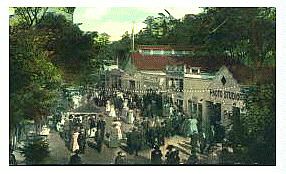
|
|
Crystal Beach Midway circa 19-0s 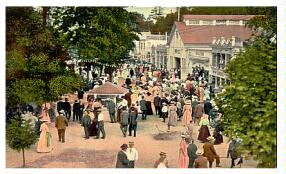
|
This image shows a different style
of postcard tinting. The photo was
taken from an altered angle, but
the same buildings are visible. No
flags or strings of lights are there,
so this was taken on a different date
from the above.
|
|
Here are the same buildings seen from
ground level.
|
Crystal Beach Midway circa 19-0s 
|
A "Figure Eight" roller coaster was installed by T. M. Harton in 1902 or 1905. It was in the park until at least the end of the 1908 season when one source indicates it may have been sold to Erie Beach Park (then called "Fort Erie Grove"), or it may have lasted until 1915, after which The "Giant" coaster, which was installed in 1916, would have taken its place. (New information refutes the sale to Erie Beach - see that article for details.)
Although several sources state 1915, 1908 may be a possible last season for The "Figure Eight", if it was removed after The "Backety-Back" went in for the 1909 season. farther on. Photo research indicates they were on opposite sides of the "Aerial Swings", so they could have run at the same time. Given that The "Figure Eight" is still mentioned in advertisements for the opening of the 1909 and 1910 seasons, it seems that both were in the park. See the "Midway" photo discussion a little farther on.)
In 1902 one of the concessionaires was George Hall. He became famous for his candy suckers, but later would sell other confections like candy kisses, caramel corn, peanuts, and popcorn. In 1924 he would become president of the Buffalo & Crystal Beach Corporation which would purchase the park in March of '24. By the 1940s he also came to operate a miniature golf course and other devices in the park.
Crystal Beach profited well enough that it was sold to yet another ferry company in 1908. This new ferry company, The Lake Erie Excursion Company, introduced a water system and built another hotel (The Bon-Air) and a bath house. They also added another ferry and revamped the midway with a new layout. Overall, the park was supposedly expanded to four times its previous size.
|
Crystal Beach Midway (Undated - See Text) 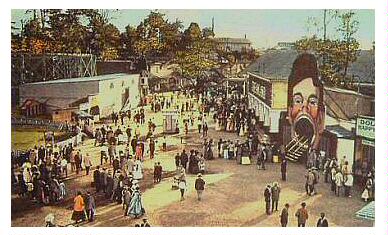
|
| At Center Right in this tinted postcard is the entrance to a funhouse. Seen at Upper left is a roller coaster. Below it at Center Left is a circular area of an unidentified amusement ride. Note the covered entrance queue and the exit gate to its left. This is likely for an Aerial Swing ride. Its picket fence, covered entrance, and exit opening match those seen in the several of the Backety-Back photos, farther on. |
The above photo poses a problem. The only funhouse references found regarding Crystal Beach in this era are for "The House That Jack Built" and for Burnett's, which was supposedly not built until 1918. However, the roller coaster structure appears to be that of a "Figure 8". This ride was supposed to have lasted until 1915 at the latest. This means that the above funhouse could not have been Burnett's and must have been "The House That Jack Built". That was opened in 1910, which fits. However, photos of this attraction don't match that shown in the above. Was this a third funhouse, or was the facade of "Jack" modified at some point?
|
Crystal Beach Midway 1910s 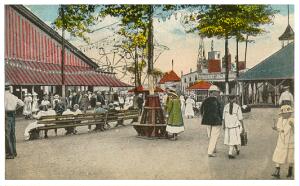 |
This is a postcard view of The House That Jack Built, located in Center background. The tower behind the tree to the left is likely for the Aerial Swings. To the left of it is a ferris wheel. |
Conversely, perhaps the "Figure 8" stayed at the park much later than some sources give, making the "face" entrance to be for Burnett's funhouse, or that Burnett's was built much earlier than references suggest. Perhaps the coaster is not a "Figure 8, but this is unlikely because the structure is one of that type and does not match either The "Backety-Back" built in 1909 or The "Giant", which would be built in 1916. If anything, this photo was taken from The "Backety-Back" coaster.
The clothing worn by the people in a photo is usually a good clue as to its date. Unfortunately, in this one, there are several ambiguities. Some of the clothing suggests the 19-0s, while other pieces appear to be around World War 1. In my opinion, most of it suggests a period around 1910, plus or minus a couple of years.
Given the clothing clues, and that I believe the coaster shown to be a "Figure 8", and that I believe Burnett's Funhouse was not built until after The "Figure 8" was removed, I must conclude the funhouse in the picture is one other than Burnett's - likely an early version of The "House That Jack Built". Thus, I determine this photo to be from 1910 - 1914.
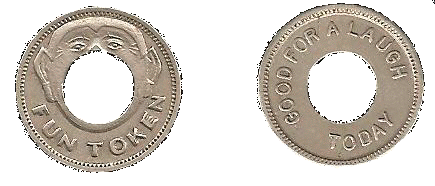 Funhouse Token Date: Likely Before 1921 It is not known to which funhouse this token applies, but the mouth on the obverse suggests that it is for the funhouse in the second previous photo. The hole is interesting because most tokens with holes are associated with bath houses or swimming facilities. |
|
Waders on the Beach circa 1912 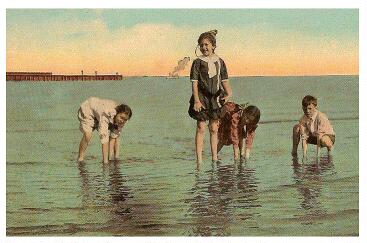
|
Children of nearly a century ago wade close
to shore while a boat approaches the pier
in the background of this hand-tinted
postcard.
|
|
A ferry (apparently Canadiana)
is moored at the park's pier beyond
swimmers playing in the water.
|
Crystal Beach Dock circa Early 1910s 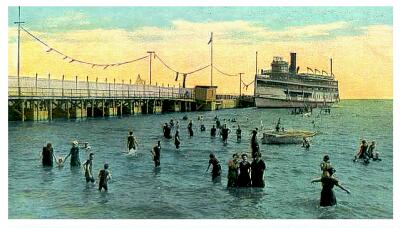
|
|
Crystal Beach Dock circa Early 1910s 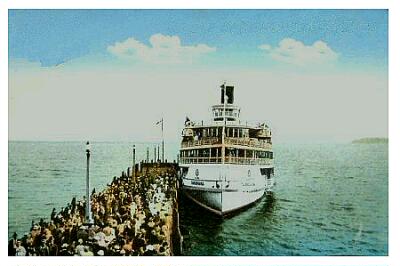
|
This image shows two lines of passengers,
one boarding and the other disembarking
the Canadiana.
|
|
Crystal Beach Dock circa Early 1910s |

|
|
Here is another hand-tinted image, but seen
from the pier looking back toward the water-side
entrance of the park. In the foreground is a
Canada Customs office for Americans crossing
the border to enjoy a day at the park.
Along the beach are various facilities for boaters, swimmers and sun bathers. Note the horse & carriage at Center Left. To the right and out of frame is the main midway. Up on the hill at Center Top background is The Hotel Bon-Air. |
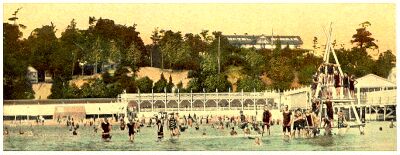
|
The Beach Area circa Early 1910s |
|
This shows the area just to the
left of the dock as seen in the
above image. Hotel Bon-Air
is at Upper Right with some cottages
seen at Center Left. On the water
is a diving platform.
|
|
The Beach Area circa Early 1910s |
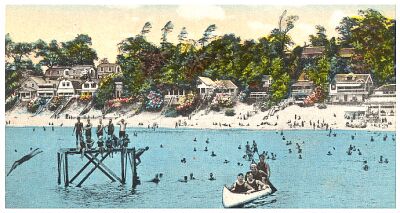 |
|
This image is farther left, still, of the
above two. The end of the beach facilities are
just visible at Center Right, with many more
cottages seen above and to the left. Another
diving platform is visible at Center Left.
|
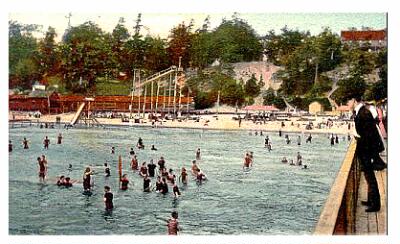
|
The Beach Area circa 19-0s |
|
Swimmers enjoy the beach in this earlier view
from the above photos. Note the lack of the
large beach facility structure near the pier.
However, there appears to be another one with
a water slide farther to the left. The structure
on stilts appears to be a dry slide with a
spiral section.
|
|
The Beach Area 1914 |
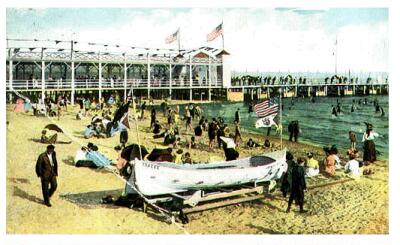 |
|
A boat rests on a wheeled dolly that runs on
a track leading to the water. It is likely a
rescue boat used by lifeguards in distress
situations. Note the American flags on the
boat and pier. This was the main entrance
to the park for those coming from The United
States.
|
 |
The Beach Area 1960s ? |
|
The extent and quality of the sand is
seen in this side view of the beach
taken decades after the above images.
|
Advertising for the 1909 Season
Proclaimed in Part:
Grand Opening on Saturday, May 29th;
57 Amusements;
15 New Attractions;
Steamer `Americana' leaves Beach 7 AM, 11 AM, 3:45 PM,
6:30 PM, 11:15 PM.
25 cents Round Trip.
A Unique Ride
As seen in the above ad, more attractions were installed in 1909. One big one was the John H. Brown-designed "Backety-Back Railway" roller coaster. Costing $50,000, it was commonly known as The "Scenic Railway", although there were no scenes along the track. It did, however, have a tunnelled section. Perhaps there were scenes in that tunnel, but no reference to any has been discovered. (Today, this coaster would be considered more of a twister layout.) It was located near Ridgeway Road but closer to the water on the same land as the kiddie area called "Frolic Land" would be located almost half a century later. It was directly across from where The "Giant" roller coaster would be built seven years later, and diagonally across from the space where the ballroom would be built a decade and a half later. The "Backety-Back" location would later become a parking lot when the automobile became the preferred way to access the park, but that would eventually be replaced with Frolic Land.
The station for this ride somewhat resembled a riverboat, having a 3-story rectangular structure with rounded faces. On top was a peaked roof with two rotunda-like cupolas. The stories were supported by pillars that framed a series of arches which appeared on 3 sides of the building at ground level, and on all sides on other levels. The entire building was on a large boardwalk-style area. Entrance was one step up from ground level through any of the arches.
|
Backety-Back Scenic Railway
circa 1910s 
|
At Center Right is the station. A train
may be seen near the top of the lift hill
just left of center. One of the reversal
tracks may be seen in front of the lift.
It's the track which ends in mid air! |
| An Aerial Swing car and its cable supports are in the right foreground. Note the woman by the ride's central tower. The fence at Lower Left extending into the background surrounds this ride. |
|
In this better view of the station, its
three-story structure is evident, especially
due to the open design.
|
Backety-Back Scenic Railway
Station Exterior circa Early 1910s  At the left is part of the layout. Just left of the station roof may be seen one of the reversal tracks. The other is at far Center Left. In the foreground is the wooden boardwalk. |
|
Backety-Back Scenic Railway
circa 1910s  This rear view shows the lift hill at Center Right, with one of the reversal tracks between it and the station. |
|
Backety-Back Scenic Railway
circa 1920s 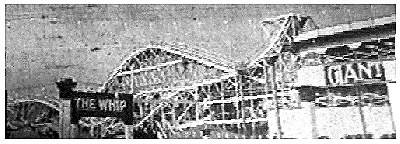 This front view, taken some years later compared to the above photos, gives a closer look at the reversal track. Note the "Whip" and "Giant" signs. |
|
Backety-Back Scenic Railway
circa 1910s 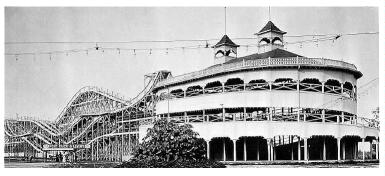 This clearer photo was taken from the "Circle Swing" enclosure. The reversal tracks are very distinct here. The sign in front of the track structure at Lower Left reads "Pony Track and Livery". |
|
A trainload of people is on the reversal
track looking down at the camera. The
lift hill lies behind and extends to
the Upper Left. Note one or two trains on
the structure underneath. They appear empty,
so this may be a storage track. It looks as
if another is on the lowest track. However,
the photo is so contrasty and lacking detail
that it is hard to tell.
|
Backety-Back Scenic Railway
circa 1910s 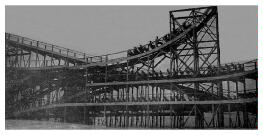 |
After entering the station, riders walked a short distance to a large stairway just inside. Here, they climbed to a mezzanine-level box office to buy tickets for 10 cents each. They then turned to their left to form a line a few metres long that ended at an admissions gate on the same level. At this point, their tickets were given to an attendant and they climbed a short stairway to the second level boarding area.
The trains consisted of two cars with 10 double seats that looked like victorian park benches, and between the cars was a position that contained a brakeman. He sat in a seat that was at the front of the second car. This setup is very similar to the rolling stock used on L.A. Thompon's or J.A. Griffiths' "Scenic Railways" and was likely copied from Thompson, Griffiths, or even bought from one of them by Brown for The "Backety-Back". There seem to be no restraints except for short sides on the seats. This must have seemed quite harrowing because several of the track sections ran up small inclines to dead ends and reversed upon themselves.
The mechanism employed to do this was a second set of wheels which engaged another track. After the train reversed, the first set of wheels engaged a track which led to a second reversal. After changing direction this second time, the train would progress in a forward motion once again and continue on its run around the circuit. This method was devised by Brown and was patented in 1904.
After the ride, a train entered the station on the third level and spiralled around inside the structure until it arrived at the second level where passengers disembarked. They apparently ran two or possibly three trains. The ride proved immensely popular and remained in the park until 1926.
|
The rotunda-style design of the inside is evident
above the riders. A train has just entered the
station at Center Top and will wind its way
counter-clockwise around to arrive on the next
level down. There, another train awaits departure. The writing on the step riser reads: "Ride 10c Buy Tickets at Box Office_ Ride 10c". |
Backety-Back Scenic Railway
Station Interior circa Early 1910s 
|
|
Backety-Back Scenic Railway
1911 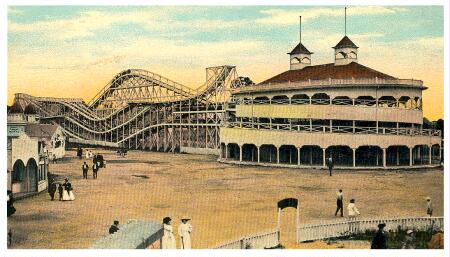
|
This wonderful hand-tinted postcard shows the
station and good detail of the ride's reversal
track.
|
|
In the foreground is the picket fence
of the Aerial Swing. The covered area
to the left is the ride's entrance, while the
arched opening in the fence is the exit. The
photo was likely taken from one of the ride's
cars or its loading platform.
|
|
This view is from a lower angle. The purpose
of the building with the arched front is unknown,
but it may have been a game.
|
Backety-Back Scenic Railway
circa 1911 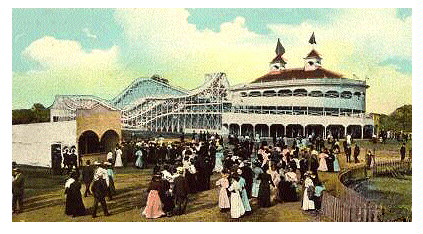
|
|
Backety-Back Scenic Railway
Early 1910s 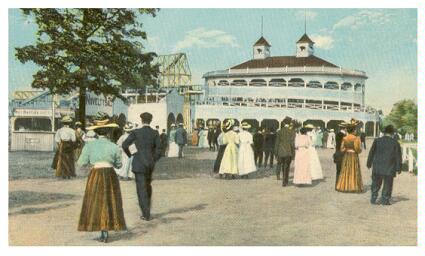
|
Another angle. This is to
the left of the above.
|
Amusements advertised for the 1909 and 1910 seasons were an "Aerial Swing" (a Traver "Circle Swing", as shown in photos here), Athletic Field and Track, "Backety-Back" Coaster, Bathing, Boating, Bowling & Box Ball Alleys (this 1908 building would later house "Laff In The Dark"), "Bump the Bumps" (likely an undulating slide like the one at Scarboro Beach), the Cake Walk, "Circle Wave" (likely a Herschell "Razzle Dazzle"), Dance Pavilion, Electric Theater, Gypsy Camp, "House That Jack Built", Japanese Ball Game (probably a "Japanese Roll-Down"), Penny Arcade, Photo Studio, Roller Rink, "Rivers of the World" (later to become The "Old Mill"), a Shooting Gallery, a theatre (not sure if this is the same as above or a second one), "Trip to the North Pole" and the "Figure Eight" coaster.
|
Crystal Beach Midway 1908 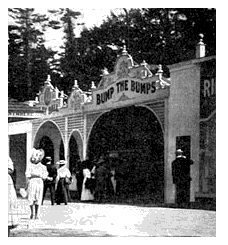 (Photo: Jim Abbate Collection) |
This is the entrance to The Bump the Bumps. |
One undated photo also shows a ferris wheel with 10 enclosed tubs located near The "House that Jack Built" and across from The "Backey-Back" coaster. (See a postcard view further back.) Another photo shows the bowling alley building with a "Pool" sign, presumably meaning "billiards". This was located across from the "Backety-Back" coaster.
Also advertised was a Miniature Railway. This may have been a second one, but likely is the aforementioned one. The engine would be replaced in 1930 or 31 and would remain steam-powered until 1948 when a diesel unit would replace it.
|
Park Token Date Unknown 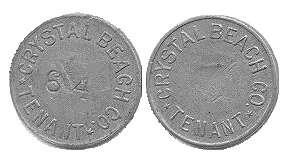 |
|
Here are the obverse and reverse
of a park token. It is assumed
tokens were used for rides or
attractions admissions in lieu
of tickets. Tokens could be
used over & over, while tickets
could not. However, the word "tenant" may refer to those staying in cottages over the summer. Perhaps they were given the tokens as an incentive to visit the park's attractions. |
An improvement for 1910 was the replacement of the wooden walkway with a concrete one. Some of that may be seen in the photo below. (Another source gives 1912 for this.)
|
A Park Promenade Circa 1910 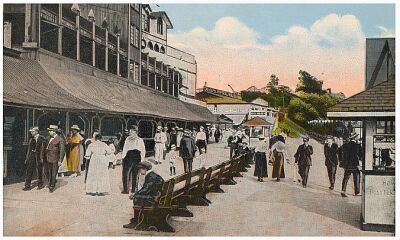 On the hill in the background is a building with a sign saying "Dexter's Imperial Roller Rink". In 1924, this hill would be removed to make way for a new dance hall. |
People stroll an area of the park away from
the main midway. At Center Right, foreground,
is a booth for boat tickets. Another booth
is seen at Center, although for what attraction
is not known. At Center Right is a metal railing
upon which are poles with what appear to be light
fixtures at the top of each.
|
|
This is the same area from a different angle.
|
A Park Promenade Circa 1910 
|
|
The Roller Rink Circa 1910  A faded photo gives a closer look at Dexter's Roller Rink. Note at Lower & Center Left what appear to be miniature railway tracks. |
One other new ride for that season was a relocated Carousel (Philadelphia Toboggan Company #12, built in 1906). This merry-go- round had 2 chariots, 23 horses and 21 other animals including a camel, giraffe, lion, wolf, and a St. Bernard dog. No word on where this ride was beforehand nor what happened to the other carousel.
|
The Carousel Circa 1940s 
|
Also mentioned is that an attraction called "Over the Falls and Through the Whirlpool" was sold to International Amusement Company but it's not clear if the ride was sold *from* the park or sold *to* a concessionaire in the park. An amusement imported from England is discussed, but few details are known at this time. It was said to be along the plan of The "Scenic Railway". Yet another coaster in Crystal Beach's past? Or was this an early flume ride?
In the background of another early photo (likely during the 1910s), it appears that there was a show that may have been called "Battle of Canada". The word "Warpath" also appears. Perhaps this was a live-action show that depicted the indian/settler conflicts of Canada's early history.
On June 22, 1910 17-year Louise Koch was fatally injured on The "Scenic Railway". (I assume this refers to the "Backety-Back", not the English amusement device.) She had ridden several times, but on her last trip, she was alone in the seat and was apparently thrown from the ride on a turn just before or just inside a tunnel. She died of head and side/back injuries 15 minutes into the boat trip taking her to hospital.
Growth
To bring even more business to Crystal Beach in the ensuing years, the company enlarged one pier and built two more between 1910 and 1921. They put two more ferries into service (3,500-passenger ships Americana and the $250,000 Canadiana - one source quotes capacities of 2,735), to handle the crowds coming to the new hotel and bath house from both sides of the Canada/U.S. border. Each had a dance floor for entertainment on the run to & from the park and The Canadiana was often used for cruises outside of its regular ferry service. It was reported to have the largest dance floor of any Great Lakes steamer.
The Canadiana was built in 1910 by The Buffalo Dry Dock Company in Buffalo, New York. Launched March 5th, 1910, it was 885 gross tonnes and was 64 metres long, 14 metres wide, and about 5.5 metres high. She ran a triple expansion steam engine rated at 1,446 ihp. Its service time for the park would run from 1910 until 1956.
|
Americana Circa 1910s 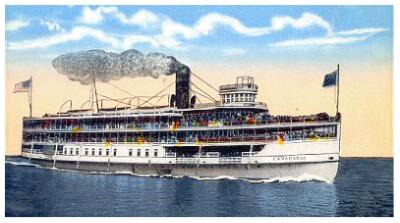 Although the name says "Canadiana", this hand-tinted view appears to be showing The Americana as it plies the waters between Crystal Beach and Buffalo. |
|
Canadiana Circa 1950s  In this later photo, The Canadiana sits at berth, likely at the American terminal. |
To accommodate the increased demand at the park for season-long housing, 25 new cottages were constructed for the 1910 season. Improvements for 1912 included a new picnic grove, stadium and field renovations, and betterment of the electric lighting. In contrast to the 1910 date, 1912 is also given as the year of installation of the concrete walkway along the lake.
The picnic grove was located near a restaurant and would come to include tables and benches to seat 6,000 (which were later covered), a bandstand with a kitchen underneath that provided hot & cold water and hot plates. There would also come to be a playground with swings, see-saws (teeter-totters), slides, and sandboxes, and even an attendant to render assistance as needed.
Additional amusements advertised for 1910 were "Fair Japan", "Hoop-La" (game), "House of Mystery", "Laughing Gallery", "Vesuvius", and a pony track. The latter was located next to The "Backety-Back", as seen in a previous photo. Concessions included ball games, candy stands, ice cream cone stands, red hot stands, soft drinks, souvenirs, and waffle stands. Some other attractions seen in postcards for this time period and later are a "Bug House", "Swing Boats", and a "Steeplechase".
|
Crystal Beach Midway 1910s 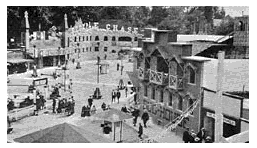 (Photo: Jim Abbate Collection) |
In the background is The Steeplechase, while The Bug-House is at the right. The latter was likely a funhouse because the term was used during that era to mean an insane asylum. |
A New Coaster
With the popularity of The "Backety-Back", another coaster was constructed across from it in 1916 called The "Giant". Costing $35,000, it was a side-friction coaster designed by T. M. Harton, although some sources cite it as a Philadelphia Toboggan design, but constructed by the park. However, it does not show up on author Charles Jacques' list of PTC coasters. Yet another source cites it as being conceived & built entirely by the park. Research continues on this.
Height figures vary, with 18 and 22 metres shown. These heights return top speeds of 68 and 75 km/h. Length shows as either 801 or 1098 metres long. Part of the reason for discrepancies may have been due to modifications done sometime in the 1930s with a rectangular `P' shaped curve near the end being condensed into a shorter, more oval one. Length was lost from this alteration, although 300 metres seems excessive. The cupola was removed at this time, as well, and a train from Erie Beach's "Blue Streak" was placed on this ride after Crystal Beach owners purchased that park in 1930. In the 1940s, an art-deco front was built for the entrance and station.
|
This aerial shot clearly shows the `P' curve of the
Giant at the lower right. The purpose of the
round structure (right), and small building to the
left of the oval are unknown at this time. The oval
was the track for the pony ride.
|
Giant
Coaster Late 1920s 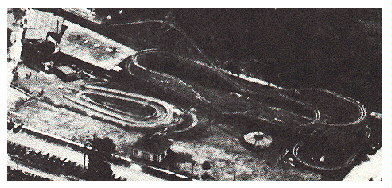 The square building at Center Bottom sits on part of the area once occupied by The Backety-Back coaster, which is now gone. The new entrance (see next) has not yet been built. So given these two clues, this photo must have been taken after the 1926 season but before the 1929 season. |
|
Giant
Coaster 1949 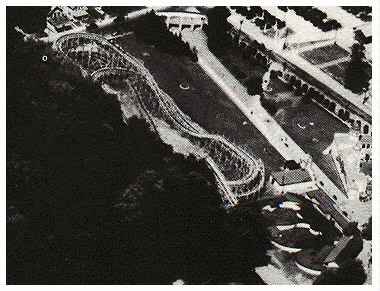
|
In this later photo, the `P' curve is
gone as are the pony track, round object, and small
building. Note the arched park entrance (built
in 1929) at Center Top. It was for the highway
side of the park. The entrance path passes over
the ground where The Backety-Back and the
pony track were. At Center Right may be seen the
edge of The Magic Carpet funhouse which
had been built two seasons previously.
|
|
A train ascends the lift. The station interior is
in the shadows to the left. To the right are two
of the outgoing turn-around tracks, one atop the
other.
|
Giant
Coaster Circa 1920s 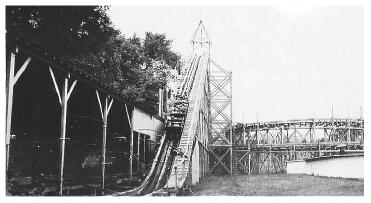
|
|
Giant
Coaster 1970s or 80s 
|
Riders smile with delight as they descend a drop. This view affords a close-up look at the car design. |
By 1987 the park ordered a complete refurbishment of the ride but I have no record that this was ever done. In fact, the ride was closed for much of that season, presumably held up by a wood shortage required for the work. However, Jeff Trunzo of Niagara Falls, New York says that the refurbishment of The "Giant" coaster was started but never completed. He continued "I recall there being a lot of replaced wood on the first hill and quite a bit on the tracking. The last year of the park The `Giant' had a pretty good bump at the bottom of the first hill. There was a lot of pressure treated wood at that spot. Speaking of wood, when they auctioned off The `Comet' after the park closed for good, they included $100,000 worth of wood with it." Jeff believes that wood was originally intended for The "Giant." Sadly, the coaster never moved to another park and it was demolished in 1989, with parts ending up in various coaster fans' collections.
Rick Doan of Ridgeway, Ontario says of the sale: "The `Giant' was bought by a group for $2500.00 (US). Some took signs; about four took cars, with one guy taking the majority. One investor from Pennsylvania kept driving up to the park, but never took anything. He came up after a few months and stapled signs all over the coaster declaring ownership and to `keep away'. The park management was after him many times to take what he wanted and in the end they tore it down."
"The whole coaster was razed in about 4 hours and that night, mysteriously, the pile of wood caught fire which made for a spectacular scene and brought out all the local fireman. We suspected the blaze may have been caused by the demolition crew so they then would not have to cart the wood away. However it was illegal to burn, hence the `mysterious' fire!"
Not much occurred for the rest of World War I, with only Burnett's Funhouse being built in 1918, and in an undated photo a Mangels "Whip" may be seen next to The "Backety-Back". This photo, seen farther back, was likely taken in the early 1920s.
|
This shows part of the Whip ride.
Note that the cars were fitted with canopies
much like the early Tilt-a-Whirl
rides sported when introduced in the
1920s. The canopies here are white with
red stripes.
|
Whip 1934 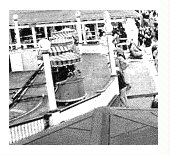 (Photo: Jim Abbate Collection) |
After the war, activity again began to be seen. The village around amusement area had flourished with the growth of the park in the two decades surrounding the turn of the century. Crystal Beach's attractions brought many seasonal tourists to the summer resort area. One such attraction was made by Frank Ellis as the first Canadian to parachute jump. That happened on July 5, 1919.
More cottages sprang up and many visitors stayed for the entire summer adding further to the village's prosperity. More than a dozen hotels were eventually built to house all these people, and they proved extra popular because they served alcohol, which the park did not.
|
Lincoln Hotel Token Date Unknown 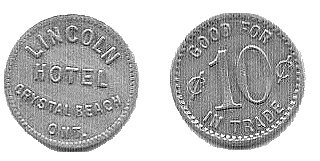
|
This is an aluminum token for The Lincoln Hotel, which was located outside of the park on Lincoln Street. It had a value of 10 cents, as is stated on the back. |
|
This is the house-brand soap offered
by the Lincoln. As with today's lodging
operations, the hotel name is on the
package. Even proprietor Buck's name
is included.
|
Lincoln Hotel Packaged Soap Date Unknown 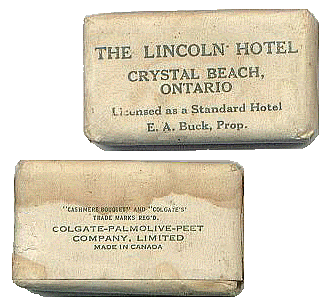
|
The day-crowds would pass through the village to get to the park. They would buy supplies to enhance the picnic goodies brought with them, as well as purchase souvenirs. Plus, after the park closed, the crowds would hang out in the village and frequent the hotel lounges and stores that had built up around the park. All this success led the park owners to go public after World War I, where upon they secured many Canadian and American investors.
In 1921, a new concrete pier was erected to accommodate the increased business. It had a two story covered section with an open upper observation deck. This upper deck was used to launch fireworks in later years. The dedication ceremony for the new structure was on May 26. The pier still exists today.
|
The New Pier Circa 1920s 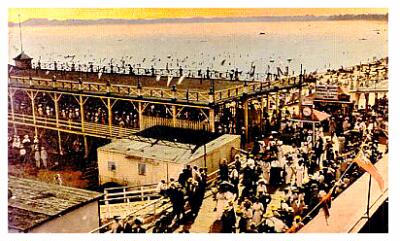
|
Throngs swarm on and around the beach end of the new pier while in the background, swimmers enjoy the water. Entrance to the park is at the bottom. |
At some point in the 1920s a long covered walkway wound from the ferry dock to in front of a new dance hall. As time went on, it gradually saw parts of the cover removed. (An aerial view may be seen farther on.)
|
The Walkway Cover Circa 1930s or 40s 
|
| The midway from near the pier shows the top of the walkway canopy. In the background lies The Ballroom and Cyclone. |
Before the 1924 season, the park and its ferries & docks in both Canada and The U.S. were bought for approximately $1,000,000 by The Buffalo & Crystal Beach Corporation. The new owners immediately remodelled the existing dance pavilion and added new lighting effects. They also put in Traver "Caterpillar" and "Merry Mix-Up" rides, plus an aerial ride. This was likely a Traver Engineering update of the former "Aerial (Circle) Swing" to a "Seaplane De Luxe". Later photos show the "De Luxe" near the Ballroom. (See photos here, farther on.) The "Caterpillar" is said to have lasted into the 1970s, but this is not confirmed. Nor is it known that if the ride did last that long, if it was the 1920s ride or a newer model.
The Continent's Largest Dance Floor
On October 2nd 1924, plans were approved for what would become the park's famous new dance pavilion. Designed by Schultz Brothers in Brantford, Ontario, they commenced construction in November of that year with the levelling of a huge hill of sand which was done in part with high-pressure water hoses. Opening May 1st, 1925 as The "Crystal Ballroom", it was advertised as "The Quarter-Million Dollar" hall, although it was actually built for $80,790. It included a large concrete breakwater a short distance away from the building to prevent erosion of the sand upon which it was built. The wall was built first in 1924 and decorated with impressions of dancers etched right into the concrete that still may be seen today. The space between the dance hall break wall was a promenade with benches where weary dancers could take a break and cool off. The "Comet" roller coaster would later take up this area and more, for its layout.
The hall structure employed steel girder fabrication, which at the time bridged the largest unobstructed dance area in North America at 50 X 70 metres with absolutely no posts to break up the expanse. On the lake side, large, segmented-glass sliding doors opened up right from the dance floor to the outside so that fresh lake breezes would cool the ballroom on hot summer nights. At each end was a balcony so non-dancers could survey the scene below or just listen to the band.
|
Crystal Ballroom
circa 1930s 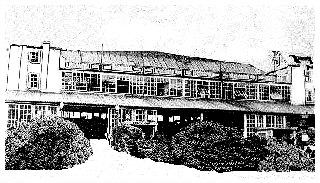
|
A well-worn photo shows one of
the entrances to the dance
pavilion. Note the large doors
opened to allow for ventilation.
|
The incredible 3,500 square-metre maple floor could hold up to 3000 dancers at once! It was so large that the orchestras and bands of the time performed on an octagonal stage dead center of the dance area. Above the stage were eight curved-wood reflectors that directed the sound out toward the floor in order to have the music reach all areas. Above this, hung a large mirror ball. Later, as amplification became available and cheap, the stage was moved to one end of the floor. A house audio system was installed to cover the far reaches of the room from the redesigned stage.
|
This fuzzy photo shows the dance
floor ringed by benches. The old
stage may be seen in the center, above
which hangs a mirror ball. The sign at the Upper Left reads "Step Inside for Next Dance. Last Boat Saturday Leaves 12:15 AM |
Crystal Ballroom Interior circa 1930s 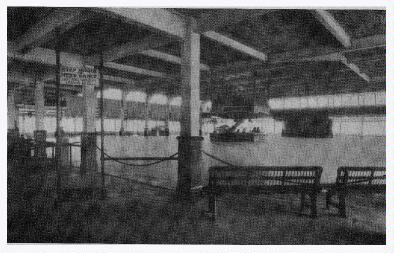 |
|
Crystal Ballroom
circa 1940s 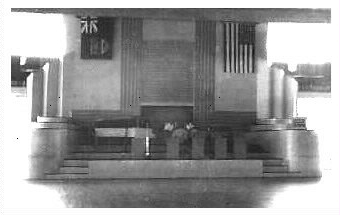
|
A new stage was placed at one end of
the dance hall. Note the Canadian and
American flags of the era, one on either
side of the back wall.
|
Two bands a night played - one Canadian and one American. Each alternated sets so that both the early and late crowds would get to hear both bands. Famous bands of that era to play Crystal Beach included Artie Shaw, Dorsey Brothers, Gene Krupa, Glen Miller, Guy Lombardo and his Royal Canadians, Les Brown, and Woodie Herman.
One incident on August 17th of 1928 spoiled the fun for many when the Attorney-General of Ontario ordered a dance marathon to stop. There were negative feelings against such things at the time and presumably no more marathons happened in the province after that point. Prize money was distributed equally among the three remaining couples. Despite this, the dance hall still set a new attendance record that year.
The park continued to add rides to its compliment including a Traver "Tumble Bug" (just introduced in 1926) and a new funhouse in 1927 (1929?). A funhouse building at the park had an optical-illusion facade and roof due to the 3-dimensional style of painting, but it's unclear if it was this new one or a revamping of Burnett's previous one. The 3-D painting appears to have been done sometime between 1943 and 1946. At some point, as additional attractions, a penny arcade and souvenir stand were located on the first floor of the new funhouse, both run by E.M. Sheriff. The installation date of these is unknown, but they were ther in at least the 1940s.
Also seen in later photos of the funhouse is an Eli ferris wheel located between it and The "Giant" coaster. One of the slides in this funhouse ended in a slippery wooden "bowl" about 2.5 metres in depth that made it difficult to exit. This building was later turned into an arcade called "Fun City". The Eli wheel would be moved over the years. It is seen in pictures east of the ballroom near the promenade (1947), by the funhouse (mid 1940s), and near the "Wild Mouse" (1960s onward).
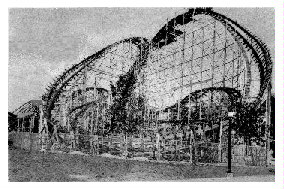 A Vicious Coaster
A Vicious Coaster
New that year, was a most famous roller coaster, The $176,000 "Cyclone". Also a Harry Traver ride, it was the first of three similar rides built in North America. The building of this one started in late 1926 and was supervised by Harry Davis and Peter Cowan. It is considered one of the most vicious coasters ever built - so much so in fact, that a nurse was hired to be on duty right in the ride's station. This was more of a publicity gimmick, but it did allow a lower insurance premium.
|
Cyclone
Coaster circa 1930s 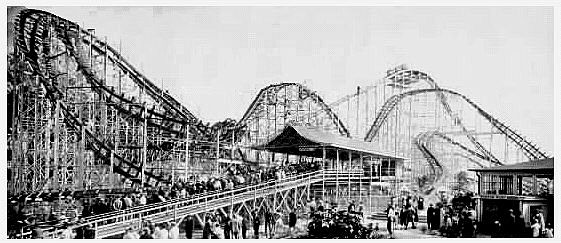
|
|
Here is an overview of the ride. Seen
to the far right is the up side of the
first drop. The lift hill and down side
of that drop are seen behind. In the foreground is the ramp leading to the station. Left of that, and behind, is the banked spiral. The edge of the building at Lower Right is the Crystal Ballroom. The lake is well out of frame to the right. |
 Cyclone Aerial Photo late 1920s |
This gives an idea of the ride's placement
in the park. To the right are the Dance Hall
and Tumble Bug. At this end is the
Funhouse while at far end is the lake. The
large building at Lower Right is not known at
this time.
|
|
A hand-tinted image shows the Ballroom on
the right and The Cyclone in the
background. At Center Left is the ramp
leading to the station which sports
the red roof at Center.
|
Cyclone
Coaster circa 1930s 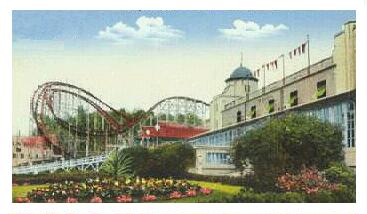
|
|
Cyclone
Loading Platform Circa 1930s 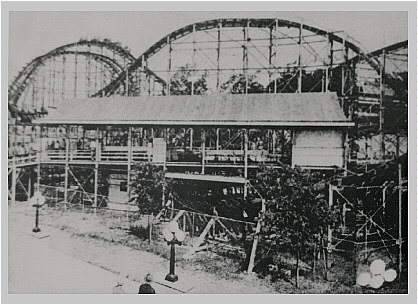 |
This shows the full length of the loading
platform. Above and behind are the ride's third drop and the canted spiral. Note the light standards with globes in the foreground. |
|
Cyclone
Entrance circa 1930s This shot looks up the ramp to the loading platform. In the far background (center top) is the lift hill and start of the first drop, curving to the right and out of frame. The track above & behind the station roof is coming towards you. It's the up side of the first drop (from out of frame right) and down side of the second drop. |

|
|
Cyclone
Entrance circa 1930s 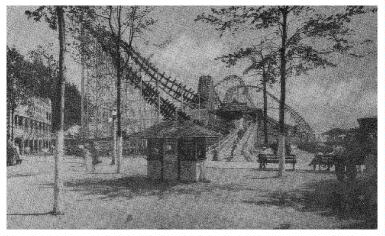 |
This longer shot shows the area near the coaster's entrance. The ticket booth is in the foreground while Burnett's Funhouse lies to the far left. This was taken before its 3-D paint job was done. Note how small the trees are compared to several decades later. |
|
In a still from a colour movie taken in the 1940s, a train has exited the spiral and is on its way up a hill to the figure 8 approach. A trim brake is located at the top of this hill. The movie is included in a video of the park. (See "Videos" at the end of this article.) |
Cyclone
In Colour Circa 1940s  |
Over 225 tonnes of metal were used in building the ride to form a steel support structure instead of the usual wood. The coaster is still considered a "woodie", though, because it used 300 X 25 millimetre wood laminants topped by a flat steel rail. Total length of wood used was about 6,100 metres - all British Columbia fir. At night, 1,000 small incandescent lamps lit the ride.
The layout consisted of a twisted arrangement of track with a 29-metre lift hill and over 900 metres of track. After a curved, first drop which banked at up to 80 degrees and bent back upon itself, the trains traversed a 600-degree banked spiral and a very fast, low-profile, figure-8 section of track. This element was banked to about 75 degrees at its maximum.
Ed Cowley, who had ridden The "Cyclone" many times in his life, said: "The first couple of turns were knockouts. Then you got into that section which is a figure 8, and that's where people got stiff necks. You got thrown from one side of the car to the other so fast you didn't get a chance to prepare yourself. You must have been travelling at a tremendous speed through that figure 8. It was quite a blow. If you were riding with someone else, you'd get all mixed up with them. If you had a date, it could be quite fascinating - hands up or not."
The ride ran one or two trains consisting of three or five four-passenger cars depending on crowds. Later, the trains would supposedly be reduced permanently to three cars to keep forces on the structure lower. However, pictures late in the life of the ride still often show five-car trains, so this policy was not adhered to all the time. Perhaps the longer trains were only run when crowd numbers were high.
|
Cyclone
Coaster circa 1930s Seen in this postcard view is the curving first drop (at Center and Bottom Right) and twisted second drop. The roof at the left covers the far end of the station. Beyond this to the left and out of sight, lies the rest of the coaster, as seen in the full view, farther back. |

|
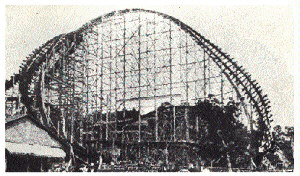
|
Cyclone
Coaster late 1920s Here is a more straight-on view of the first drop (right) and second hill (left). |
Other than one trim brake, there were no brake runs outside of the station as there were no level portions of track where brakes could be located! (The trim brake was between the spiral's exit and the figure 8 element). Ride time was around 40 seconds, discounting station to top of the lift, which extended the time to a total of about 70 seconds. This would have been slightly faster than before opening day because almost half a metre had been removed from the height of the second hill due to roll-back problems.
The "Cyclone" was said to place over 4 Gs of force on passengers, and had a top speed approaching 100 km/h. Although the G-force statistic is likely true (and in fact may be low), the speed is definitely an exaggeration. The maximum velocity attainable from lift height to ground level, which the first drop did, would be 84 km/h.
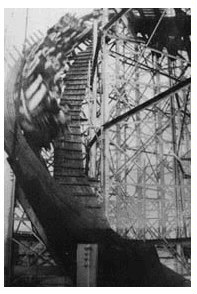
|
Cyclone's
Third Drop 1928 Plummeting from a height of 24 metres at a steep angle, the train has entered the banked spiral. Exiting this, riders were led to an intense `figure 8' element. |
|
Cyclone's
Figure 8 circa 1930s 
|
|
Here, a three-car train has dropped to ground
level and is severely banked. The high speed
and curvature of the track keep riders firmly
in their seats. Note the ribbed supports in
the foreground and tangle of coaster structure
in the background.
|
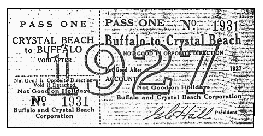 Reports say the ride drew 75,000 on opening day and crowds were so
heavy that a railing was broken by those pushing to get close to the
new ride. One patron rode 67 times that day and on its second day of
operation, two boys rode 52 times. Over 5 million rides were given in
its 20-year history with only one fatality. This occurred on opening
day May 30th, 1938 when a 22-year old man was thrown from the train
after the first drop. A failed lap bar was deemed to be the cause and
the rider's estate was awarded $3000 by the court.
Reports say the ride drew 75,000 on opening day and crowds were so
heavy that a railing was broken by those pushing to get close to the
new ride. One patron rode 67 times that day and on its second day of
operation, two boys rode 52 times. Over 5 million rides were given in
its 20-year history with only one fatality. This occurred on opening
day May 30th, 1938 when a 22-year old man was thrown from the train
after the first drop. A failed lap bar was deemed to be the cause and
the rider's estate was awarded $3000 by the court.
This coaster unfortunately, turned out to be a maintenance headache due to the high forces generated. Some reduction was gained through the use of three-car trains, but still the track suffered. So in 1938, the entire ride was overhauled (supposedly by Herbert Schmeck) with many extra stress ties added. These may be seen in the photo below.
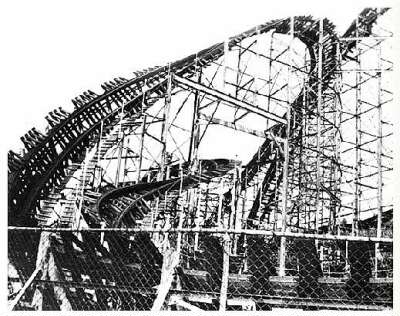
|
|
Cyclone's
First Drop Post 1938 Overhaul This is the first drop which falls (out of frame, right) from the lift at Upper Right and curves back into frame at ground level as seen behind the chain-link fence. Note the extra stress ties as compared with the postcard picture seen farther back. The track in the center is coming toward you and has just exited the Figure 8. |
In 1929 the park created a new illuminated 9 X 18-metre arched entrance gate fronting on a highway at the back of the park next to The "Giant" so as to keep up with the popularity of automobiles. Just inside this gate was an entrance building with a large "Playland" sign on it. Three parking lots were provided with a free one at the gate and two fenced & guarded 25-cent pay-lots farther inside park limits.
This entrance was apparently replaced in the late 1940s, as seen in the second photo below. However, it may be that this was another entrance. Research continues.
|
Park Entrance 1930s 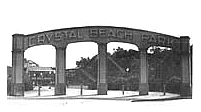
|
|
|
Park Entrance circa 1948 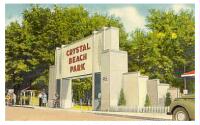
|
The rides area was extended from the end of the old midway to this new 1929 gate and additional attractions installed for the 1930 season along this new stretch. They included The "Old Mill" (a dark, water ride costing $30,000), an Auto Ride (Traver), and a Funhouse ($15,000 each). It's unclear if this was yet another funhouse, or if this or the previously-mentioned 1927 date is incorrect. One game mentioned for this time period is "Electric Penny". Also improved for that season was the park's lighting.
With this increase of motorists as patrons, "Americana" was taken out of service after the 1928 season. Also mentioned for the first time in advertising was a fireworks display for opening weekend.
The Depression Era
The park continued to grow through the 1930s and 40s despite The Depression, a brush with bankruptcy, and company restructuring. Early into the decade, the company would split into three, with Vernon Keenan becoming the park manager and George's son, Ed Hall, taking over Vernon's Rides Manager position. The owners bought the former property of nearby Erie Beach Park, which had closed in 1930 due to loss of business. They wanted to be sure that no competitor would use the property to set up an amusement park which might lessen patronage at Crystal Beach.
Some things from that purchase ended up at Crystal Beach including a miniature train (originally at the 1901 World's Fair[*] in Buffalo), some games, other rides, and the previously mentioned "Blue Streak" roller coaster train was brought to the park for The "Giant".
Other improvements made during the 1930s were the building of a new 10,000-person bathhouse and a second miniature golf course. The parking area was doubled and picnic grove enlarged (all 1931), and the aforementioned layout was changed on the "Giant". Additional work saw the paving of the midway (1939), and the installation of a Chambers "Laff In the Dark" (1936). This ride was put in the old bowling alley/box ball building. It was a dark ride that consisted of 12 cars traversing a course with sharp turns & bumps that was full of spider webs, scary sights & sounds, and various gags. At the entrance, greeting prospective riders, were "Charming Charlie" and "Laughing Sal", mannequins that moved and made sounds. For the full story, see: Crystal Beach: Laff in the Dark.
Picnics continued to do fairly well during this period, with the grove capable of seating up to 6000; but it was the beach that drew many. It had fine white sand, lifeguards, diving platforms & slides, and at one point a "Sea Swing" in the water. Next to the beach was a large bathhouse. An advertisement from when it first opened over a decade earlier stated that the bathing pavilion could accommodate 3500 persons. As mentioned earlier, in the 1930s it was rebuilt to accommodate 10,000.
|
The Lakeside Promenade circa 1930s 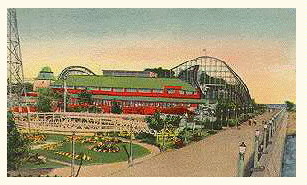
|
This walkway and seawall would be
the site of The Comet coaster by
1948; but in this hand-tinted 1930s
postcard, The Cyclone still reins.
It is partially obscured by the huge
dance hall. In front of that is the structure for The Tumble Bug, and to the left is the tower for The Seaplane De Luxe. |
|
There are no cars on the rides, so this
picture was likely taken in the off season.
|
A tradition started sometime in the 1930s or 40s was the Labour Day parade to celebrate the end of the season. All the permanent residents, summer cottagers and day tourists would hold a big procession down the main street of the now, town of Crystal Beach. They would often wear funny costumes and dress up their vehicles. This tradition continued until the park's demise. During the 1960s, this had the added feature of the "Bury the Summer" ceremony whereby "pall bearers" would have a wooden coffin in the parade. It would be taken to the beach, pushed out into the water and set ablaze. As the flames died, so did that summer
Prosperity Returns
With World War II, came more business for the park. The 1940 season saw a 15 - 20% increase in Patrons, with the dance hall, "Laff In the Dark" and The "Old Mill" being renovated. Fifteen new ticket booths were added to the midway. Part of the reason for this may have been the 50th anniversary celebrations. 1940 also saw the death of Crystal Beach Transit Company general manager, Harry Hall, and the appointment of former Traver Engineering's James T. Mitchell as park superintendent.
|
50th Anniversary Token 1940 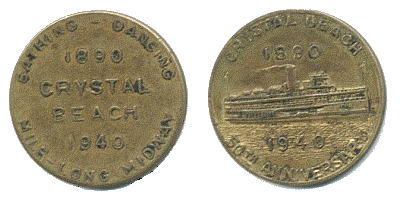
|
| This coin features Canadiana. Note the "Mile-Long Midway" slogan on the opposite side. |
IN 1943, an Eyerly "Octopus" was installed in the park.
|
Octopus
Mid 1940s 
|
The Octopus sits here between The Cyclone and The Ballroom. Later, it was moved closer to the ferry dock. That location may be seen in the Wild Mouse photo farther on. |
At war's end the park boasted 20 rides (including 6 kiddie rides), a dark ride, 16 games, 4 refreshment stands, a roller rink, ballroom, a funhouse and a penny arcade (both run by the E.G.& J. Knapp Amusement Company, which ran arcade and ride concessions in many Canadian parks), shooting gallery, ponies, bicycle/race track, a golf course (likely miniature golf), picnic facilities for 5000 (6000 ?), and a 4000-seat grandstand overlooking a large athletic field. Some ride names seen are "Tumble Bug" and "Caterpillar" - both from Traver Engineering. One source mentions a "Rocket Ride" but this may be confused with The "Rocket Ship" (see below). Also referred to is a second stadium for athletic events, but no additional information has surfaced as to when this was installed.
In 1946 the park's power lines were placed underground and plans were made to replace The "Cyclone" with a new, longer ride capable of running three trains: The "Comet". This was discussed earlier.
A New Funhouse
During the 1947 season when the park was without a coaster, The "Magic Carpet" was erected. It replaced an attraction called "Spook Alley" and also the Pony Track run by Tom Dillon. A photo from 1949 shows that the funhouse near to the ballroom was gone (turned into the "Fun City" arcade), so The Magic Carpet was likely the only one in the park by this time.
|
Burnett's Funhouse
1943 or Earlier |
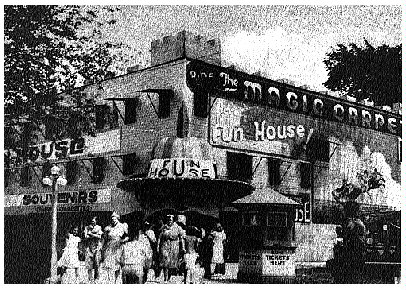 Despite the sign, this is not The Magic Carpet funhouse. It is Burnett's. Apparently, this had a gag that went by the same name. The Magic Carpet funhouse is pictured in the two images following the one below. |
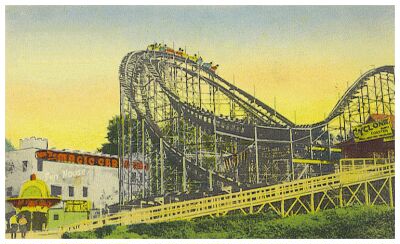 A hand-tinted view of the same building, and also showing The Cyclone entrance ramp and spiral. |
Burnett's Funhouse
1943 or Earlier |
|
Magic Carpet
Circa 1947 |
 This is the actual Magic Carpet funhouse. |
The "Magic Carpet" was designed by Norman Robins and Eldon Knapp. The latter had a rides & concession company that placed many attractions in Canadian amusement parks. It consisted of items such as air jets, distorted mirrors, slides (one of which ran inside, outside, and back inside the building), misshapen walls and floors, darkened maze passageways, a 3.5 X 4 metre rotating barrel, and an area called The "Lily Pads", which patrons would try to navigate without getting their feet wet.
The ending consisted of a conveyor belt driven over steel rollers which was the magic carpet. This lasted until 1972 when insurance concerns dictated this last gag be removed. The attraction was renamed The "Magic Palace", which lasted until the park's demise in 1989.
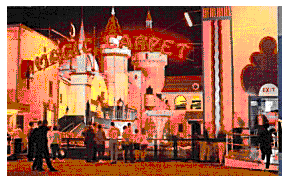
|
Magic Carpet
1960s |
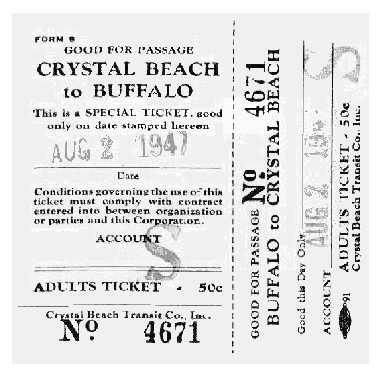 A 1947 aerial photo shows the athletic field, the beach &
bathhouse, the Ballroom, parking lot, and the midway, upon which are
just visible The "Tumble Bug" and "Scenic Canal Ride", among others.
Also shown is the two-level dock for the ferries that had opened in
1921, as described earlier. The upper level viewing gallery and
promenade is clearly seen. In later years it would become a station
platform for The "Sky Ride".
A 1947 aerial photo shows the athletic field, the beach &
bathhouse, the Ballroom, parking lot, and the midway, upon which are
just visible The "Tumble Bug" and "Scenic Canal Ride", among others.
Also shown is the two-level dock for the ferries that had opened in
1921, as described earlier. The upper level viewing gallery and
promenade is clearly seen. In later years it would become a station
platform for The "Sky Ride".
A new ride that year was the Chambers "Rocket Ship". Located near a "Hi-Striker" game and between The "Magic Carpet" and another Chambers attraction, "Laff-in-the-Dark". It consisted of a central 26-metre high tower with six sweeps to which were attached stainless steel cars with a 4 X 2 seating arrangement. They had pointed noses and flaming tails. The tower was enclosed within a pavilion-like structure which had a circular walkway one story above the ground where passengers boarded and disembarked. A clock adorned the face of one side of the structure.
In operation, the ride was the same as the turn-of-the-century Traver "Circle Swing". Chambers had been a Traver employee and when later running his own company, he made replacement cars for the Traver rides. Since the park had both a "Circle Swing" and "Seaplane De Luxe" in the past, one might assume this was the same ride with new cars and theming and that it was moved from its old spot west of The Ballroom to north-east of The Ballroom. However, one aerial photo shows both towers; the "Seaplane De Luxe" one still stands near The "Comet", while The "Rocket Ship" one is next to The "Magic Carpet". It's unknown if "Seaplane De Luxe" continued to run or not after the new ride was installed. (See Scarboro Beach Park for a "Circle Swing" description, and Dominion Park and Hanlan's Point for pictures.)
|
The attendant at Center Left is contributor Brian Westhouse's father! |
Scenic Canal Ride
1950s 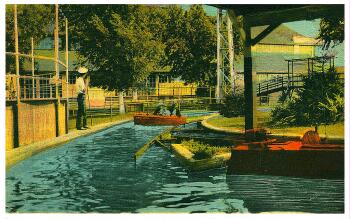
|
Enthusiast Bill Steele, formerly of Williamsville, New York, remembers The "Rocket Ships" as being in the park earlier: "It was definitely there before 1947. I rode on it when I was in grammar school, which takes it back to the early 40s."
Another new ride was the Lusse "Auto Skooter". This $50,000 bumper car ride had 30 cars and was located next to The "Fin City" Arcade. It ran until the park's closing in 1989 when it was sold during the auction for about $11,200 Canadian.
![]() Cyclone is Replaced
Cyclone is Replaced
The "Cyclone" was eventually torn down in 1946 because maintenance costs had again crept up. Peter Cowan, once again, supervised. The steel structure was salvaged and used in part to construct the huge "Comet" coaster that would open in 1948.
|
Cyclone's
Former Location 1949 
|
|
Here, to the right of the Dance Hall, is the empty
location where The Cyclone once stood. Its
Comet replacement may be seen running along
the bottom of the photo. At Lower Left is The Sea
Plane Deluxe tower. The Tumble Bug is
between The Comet and the Dance Hall. To
its left are The "Flying Scooters". Under the oval
canopy is The "Hey Day" ride with the "Water Skooter"
between that and the dance hall. Note the covered walkway running from Center Left to Center Top. It started at the ferry pier, out of frame left. |
|
This view, taken from The Comet is a
few years later than the one depicted in
the photo above. At Lower Left is The
Flying Scooters; to its right is
The Hey Day. The covered walkway
is still fully intact.
|
The Midway 1950s 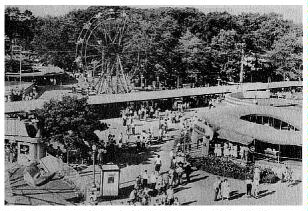
|
|
Midway Ferris Wheel circa 1950s or 60s 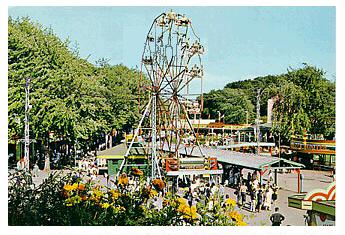
|
Another view of the 16-tub wheel and
the midway was taken a few years later.
Note that some of the walkway's
covering is now gone.
|
|
Cyclone's
Replacement 1960s  |
|
This later photo shows that the empty Cyclone
spot has been filled by the Turnpike Cars.
Notice the change of other rides. At Lower Left The
Wild Mouse ride is seen at the western
end of The Comet and the carousel building has
taken the place of The Hey Day. Also, most of
the covered walkway seen in the previous photos is
now uncovered. The ferris wheel can still be seen at
Center Left. Near Upper Left is the Giant coaster
and to its right, partly hidden by trees, is The
Magic Carpet.
|
The "Comet" was designed by Herb Schmeck (he was supposedly responsible for The "Cyclone" overhaul) and is Philadelphia Toboggan Company coaster #112. It is the third of the Schmeck cousins, often referred to as "The Triplets". The Hersheypark "Comet" (1946), the San Antonio "Rocket" (1947) (now The "Phoenix" at Knoebels), and The "Comet" each have similar track elements in their design.
John Fetterman of Knoebels Amusement Park in Pennsylvania and Shawn Mamros of Arlington, Massachusetts have both pointed out that additional coasters should be considered for addition to the Schmeck triplets: PTC #110 (1947) at Meyers Lake and the Fontaine Ferry Park "Comet" PTC #116, 1951 - 1969) share similar design features. John also thinks that the Joyland Park (Kansas) coaster (PTC #113, 1949) might be worthy of consideration, as well.
Schmeck sent John Allen, an engineer with PTC, to Crystal Beach to refit the "Cyclone"'s steel into the "Comet" design. About 60% was salvaged, keeping the price of the new coaster down to $125,000. This included the entire lift hill and most of the steel framework. After adding the additional steel required to complete the ride, the total weight of metal exceeded 270 tonnes. Allen also designed the station and brakes, as well as the chain system to fit in the old "Cyclone" chain trough.
As already mentioned, James Mitchell, who had worked for Harry Traver and had helped to build the "Cyclone" ride in 1927, went to work at Crystal Beach in 1940 as park superintendent. He supervised the building of this new coaster with an in-house crew. Stretching almost a quarter kilometre along the waterfront, the ride would occupy part of the promenade on the lake side of the ballroom. This would be a loss to dancers as they had often liked to sit out there on hot nights.
|
Comet
Roller Coaster 1950s 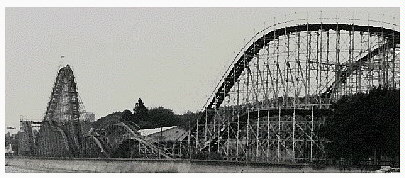 |
|
At center left is the lift and first drop, coming
towards you. To the far right are the first and
third turn-arounds, with the third being lower
and slightly outside the first. The second turn-around may be seen at the lower left, mostly obscured by the lift hill. |
The "Comet" used three 4-car, 3-bench trains. It was a double out & back design, 29 metres in height with a 27-metre drop, and was 1280 metres in length. This made it the largest of the three triplets. The original train stylings included windscreens on the lead cars and circular grab bars on each side of each seating position to facilitate rider entrance & exit. Construction continued through 1947 and the ride finally opened May 22, 1948. After Crystal Beach closed, the coaster was sold at auction for $210,000 and moved to The Great Escape in New York State where it operates today. It reopened in 1994.
|
This shot was taken from the same angle
as above.
|
Comet
at Night
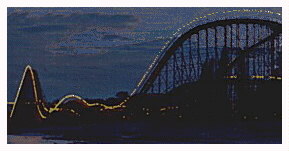
|
|
Comet
Steel Work Circa 1970s 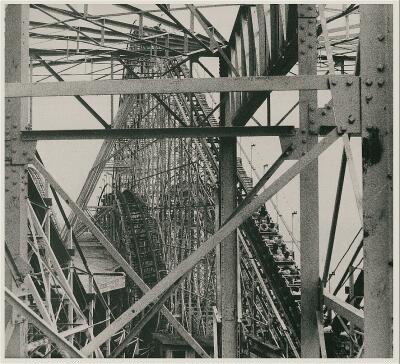
|
Seen through this tangle of girders is a Comet
train on the lift hill. Much of the steel here,
including the lift hill, came from The Cyclone.
|
In 1948, the steam locomotive on the miniature train was replaced with a diesel unit. Cars were replaced, as well, and matched the engine in style & colour. Track length was approximately 600 metres through a wooded area.
|
Miniature Train
1950s 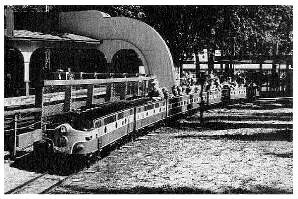
|
For 1948, the "Auto Skooter" continued to entertain patrons and the new "Comet" coaster opened. Burnett's Funhouse is mentioned by one source, but it's unclear whether this remained in the park for very long after The "Magic Carpet" opened, or not. Bill Steele says: "My recollection is less clear, but I think the old funhouse remained in operation for a year or two after The `Magic Carpet' opened." If the 1947 construction date is correct, the old funhouse was unused by 1949, as seen in the "Former Location" photo farther back. (It was turned into The "Fun City" Arcade then or afterwards.) So at the most, only the 1948 season might have seen both funhouses in operation.
Sometime around 1949 a boat ride was installed. The "Water Skooter" was built by Herschell. it consisted of a bumper-car style layout with an overhead electric grid and a "floor" of water. The two-seater boats were mahogany with a pole extending from the back of the boat up to a contactor brush which drew power from the grid. It's unclear to where the return leg was attached. A rubber bumper extended around the perimeter of each craft for protection. Later (1979 ?), these boats were either replaced or upgraded to be self-contained via rechargeable batteries, and the electric grid was removed. These newer versions had white plastic(?) tops with windscreens and had no rubber bumpers. The name "Ward" is also associated with this ride. Perhaps this company supplied the newer boats. At the park's demise, there were eight of these craft in service.
|
Water Skooter
Early 1950s 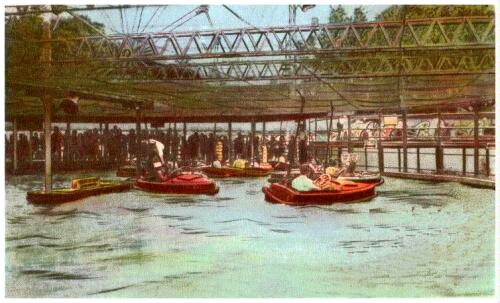
|
| (Card Scan: Ken Jones Collection) |
| This is an interior view of the ride. Note the overhead grid and contactor poles between it and each boat. Left of Center Top is a light standard with one fixture partially visible. To its left in the background is the ferris wheel structure. At Center Left is a horn speaker of that era for the ride's public address system. In the right background can be seen the cars of an unknown ride. |
One nice thing in the 1940s was "Goodwill Day" where all rides were 5 cents. This typically occurred on the Wednesday before Labour Day, which was the final weekend for the park each season. It was a way for the park and its concession ride owners to show appreciation for a good season. Because of the price, it was often referred to as "Nickel Day". There is no word as to when this practice was dropped.
|
Acrobats Entertain Circa 1940s 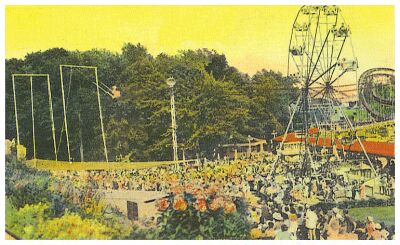 The long red roof is the walkway covering. The other red roof seen between the ferris wheel struts is for a photo booth. At Upper Right may be seen part of The Cyclone. |
Times Change
By the 1950s the big bands were waning as smaller groups took over, and the dance hall became less popular, with park attendance falling off as well. The Hall family gained full control of the park early in the decade. New rides in 1950 were a "Moon Rocket" (Herschell), a "Rock-O-Plane" (Eyerly), and a "Sky Fighter" (Herschell).
Ferry service from Buffalo was suspended in 1956 due to rising costs, a general decline in patronship due to the continuing increase in the use of cars which had seen The "Americana" taken out of service almost three decades earlier, and a 1956 on-board riot. This occurred May 30th when there were an estimated 15,000 - 18,000 persons in the park. It began with Buffalo gangs throwing bottles and starting fights, with male and female members assaulting people in the park and along the beach. Canadian police were called in but were unable to break up the many skirmishes. They did however, arrest nine persons. The remaining troublemakers eventually left the park and continued their terrorizing activities aboard The Canadiana.
No police were available due to an international agreement which barred them from boarding. This allowed the youths to roam uncontrolled, with the crew powerless to stop them. Firecrackers were thrown, giving powder burns to several. Frightened passengers either barricaded themselves in the dining room or behind roped-off areas, protected as best as possible by the crew. When the boat landed, Buffalo police herded people away from the dock as quickly as possible to prevent more skirmishes, yet they arrested another three. Six persons went to hospital, but scores of others refused treatment, wanting the ordeal to simply be over.
With that exception, Canadiana never had an accident or injury. The result of boat service loss was that the remaining ferry supporters had to arrive via Canada Couch busses or cars, creating major traffic jams and parking problems because the park had always been set up to handle most crowds arriving by boat, not by road. The last straw was due to that riot. Service discontinued immediately after the incident. Barring bad weather, The Canadiana had made six round trips a day (an hour each way) totalling 230 kilometres, and had carried an estimated 18,300,000 passengers over its service life for the park.
She was sold in 1960 and towed to Cleveland where it was unofficially renamed Pleasurama. During the years 1960-67, she was moved to Buffalo, New York, Fairport, Ohio and back to Cleveland. Here, she sank at her berth on February 17, 1982. Refloated in May of 1983, she was towed to Ashtabula, Ohio. At that point, The Friends of the Canadiana purchased the ship for restoration and had it towed to Buffalo during September of 1984. Finally, in July of 1988, it went to the dry dock at Marsh Engineering in Humberstone, Ontario, where it apparently remained into the new century. Unfortunately, not enough money was raised and this once great ship was scrapped in 2004. The propeller was saved and donated to a memorial park on the old Crystal Beach site by Rick Doan and Paul Kassay.
In the mean time, lack of ferry transport and the traffic jams on the roads served to lower Crystal Beach's attendance even further. In order to attract patrons once again, the dance hall was converted into a roller rink and many new rides were installed. Note that A. Dexter had had a roller rink concession in the park for over 40 years. The first location was on the sand hill (see photo farther back) that was later removed to make way for the dance hall. Ironically, Dexter's third location was now that very dance hall. Roller skating would continue there until 1974.
A previously unmentioned ride seen during the 1950s is the Herschell "Looper" by designer Norman Bartlett. This ride took up a 12 X 16 metre space and consisted of a circular track with ten circular cars standing on their sides. Two riders sat belted inside facing each other with their backs against the outer rim of the car. Each car was supported by a sweep coming from the center of the ride to the center of the car As the ride revolved, the sweeps rotated but were set up to turn freely inside the cars, which were balanced so that they remained upright. However, each rider had a brake pedal that could engage the rotating sweep and turn the car & riders head over heels. It was possible by pressing & releasing the pedal to hold one's self upside down, or by keeping the brake on, the car would continue to turn head over heels. The "Looper" sat right behind The "Scrambler" and lasted at least until 1974 and possibly till as late as 1977, as remembered by Bill Pfeifer of Rochester, New York. A couple of chairs from a "Looper" car were mounted to the park's entrance sign during the 1970 and 80s.
Another ride installed around this time was The "Auto Turnpike". Bill Pfeifer volunteers: "The `Turnpike' was a very popular late 50s or early 60s addition. I know it was there in '61 because I was too short to ride even though I was over the minimum age of 10. Later, around '68, the `Turnpike' cars had been converted from gas to electric leading to eventual demise of the attraction. It just wasn't the same with electric motors and the tether from the electrical track beside the roadway." In the early 70s, this ride was taken out and replaced with others.
Bruce Brooker provided the information that Crystal Beach was literally a second home for him when he was growing up: "From age 0 to about 7 my family ran concessions which were located under The Crystal Ballroom from about 1953 to 1960. Between my dad, brother, cousins, aunts and my mom, we ran a checkroom, an archery range, a bowling alley, and a billiards area in the basement under the dance hall. I knew everybody - used to be babysat by the pinboys, actually sitting up there with them whilst they did their thing! Sometimes when it got extremely busy downstairs, I'd be with the guy who ran the little scenic train, sitting in the engine with him for a couple hours."
Evidence has now surfaced that Crystal Beach had a Herschell "Rodeo" ride. This was a kiddie carousel-style of ride consisting of eight horses, each attached to the end of a sweep which would move up and down similarly to an Eyerly "Octopus". Each horse came equipped with a gun which was used to shoot at targets, and which would be stored in a holster when not in use. The ride was at the park in the mid to late 1950s and possibly into the 1960s.
Bill Pfeifer says: "I don't have specifics but I think it was in the 56-60 time period since I was 6 to 10 years old then. It may have been there later, but when I got older, I didn't spend much time in kiddieland."
Bill continues with The "Rodeo": "You could shoot the guns at targets, which were cowboys and/or indians, and illuminate a light bulb and ring a bell, if I remember correctly. "Rodeo" was located in kiddieland in the center, more towards the street rather than closer to the lake."
The kiddie area was called "Frolic Land", so this may have been a Conklin concession. Conklin used the name in the 1940s at The Canadian National Exhibition, and in 1959, they opened a Frolic Land park in London, Ontario.
|
Here is the entrance to the kiddie area.
|
Frolic Land Entrance Circa Early 1960s 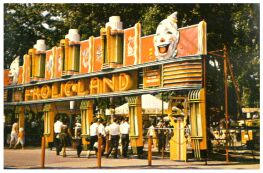
|
In addition to the rides just mentioned, the "Former `Cyclone' Site" photo taken in 1949 and seen farther back, shows "Flying Scooters" (Bisch-Rocco) near The "Comet". Also seen is the long covered walkway from the ferry dock. It was lined with benches and bisected the midway where it ran between the ferris wheel and The "Hey Day". This appears to be the same as the Spillman "Hey Day", which came out in 1925. It was a ride similar to a Mangels "Whip". Four-passenger cars shaped like autos of the time were hauled along an oval track via an under-track cable. The cars were attached at their fronts to this cable through a narrow opening in the track much like today's slot-car racers. The rear wheels were castors that allowed the car to pivot in either direction. As the cars reached the corners of the oval, they swung out like a "Whip" car but without the spring mechanisms. A similar ride was at The Canadian National Exhibition in Toronto around the same decade, so this may have originally been a Conklin concession. According to researcher Jim Abbate of Chicago, the ride was still at Crystal Beach in 1978.
The Wild Mouse
For the 1959 season, a new roller coaster was added. An old brochure shows a 2-passenger car on rails. Kevin Braunschweiger of Mentor, Ohio says that this ride was a "Wild Mouse". It was situated north of the west end of The "Comet". Sure enough, old photos indeed show a "Wild Mouse" ride next to The "Comet". Kevin goes on to say that the ride ran 4 to 6 cars which sat two passengers in tandem (toboggan-style).
The structure consisted of a red-painted framework shaped like a large 3-dimensional rectangle with the tracks running internally. The front had a sign illuminated with yellow incandescent lamps which spelled out "Wild Mouse" in script. Additionally, the structure itself had the track outlined in clear lamps that enhanced the perception of speed at night.
Rose Jankowiak of Cheektowaga, New York provided the information that the "Wild Mouse" letters were backlit and located at the top of the first set of hairpin turns. This conflicting information means that the sign was changed sometime during this ride's stay in the park from separate lamps to backlit letters. In addition, the new sign was moved to the rear of the ride at some time. This is proven by photo research, but it's unknown when the sign type was changed nor when the changed sign was moved to the rear. It appears that the backlit sign went in around the early 1960s and was moved to the rear during that decade.
The ride came from Conklin Shows which had (and still has) the Canadian National Exhibition midway contract. They were the agent for German manufacturer, Heinrich, but the Crystal Beach ride was apparently made by Zierer, which had a close relationship with the Heinrich company.
|
Wild Mouse
Date Unknown (Early 1960s?) 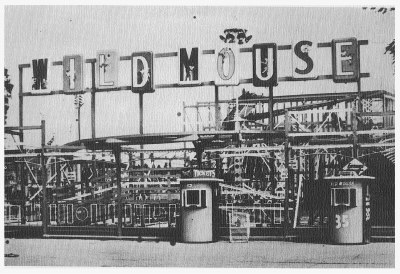
|
The entrance to the ride is shown here.
At this time, the backlit sign stands
at the front of the ride. What appears
to be paint missing from its letters
is actually little `mice' figures
crawling around them. Note above & behind the `0', a light standard sporting a round of floodlight fixtures. |
|
In a view from atop the ferris wheel, The
Mouse structure is clearly seen.
Although not easily discerned, this shows
the backlit letters at the top rear of the
ride. Note the short tower at the left front
of the upper part of the track. It appears
to support a winch. To the left is an Octopus and The Comet coaster. The ferry dock is in the background. The covered structure to the right is part of the boardwalk. |
Wild Mouse
and
Comet
Circa Mid 1960s ? 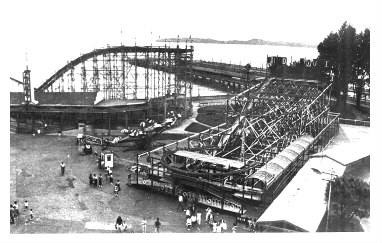 Bill Kae Collection |
Recent evidence from Victor Canfield of Hershey, Pennsylvania shows that Conklin ran The "Mouse" as a concession which the park seems to have later purchased. It was reported in 1958 that one "Mouse" was to go to Crystal Beach for 1959, and a 1960 report says Conklin had a half interest in that ride at the park. Given that a booklet showing the CNE "Mouse" ride as two different models over a period of years may mean that two "Mouse" models may also have been at Crystal Beach. This would explain the different locations of the lettering.
The ride started with a chain pull up the left side all the way to the top which was about 12 to 15 metres off the ground. The cars then traversed a path back and forth across the top of the framework with 7 or 8 sharp 180 degree turns at the edges of the frame, all the while building speed. At the end of this course at the top, the track dropped within the framework to become a violent rage of a coaster with very quick drops. This gave lots of opportunity to grab your sweetie seated between your legs, to make sure she was safe and would not fall out!
I have no exact year when this ride left Crystal Beach, but Kevin feels it was there until at least 1972. Since $20,000 worth of retracking was done in 1971, the ride would likely have been kept for more than just one year afterwards. Tom Delano says the ride was in the park till 1980. Tim Wagner of Fairport, New York also believes the ride lasted until 1980. Since ads for 1978 mention this ride, it was there at least until that season.
|
Wild Mouse
and
Comet
Coasters
circa 1970s 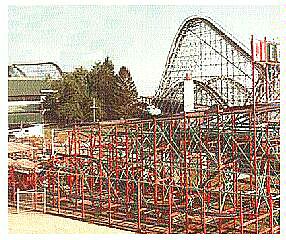
|
A bright sunny day shows the Wild
Mouse. This sports the backlit sign,
visible at Upper Right. Behind is
The Comet. Its first turn-around
may be seen above the Dance Hall's
roof, at Upper Left. |
The 1960s and 70s
The 1960s have little information. The park struggled during the decade but did manage to add new attractions. In 1961, a Huntington miniature train began operation. This replacement for the 1948 unit had a diesel engine, but it looked like a steam locomotive. Louis LeJeune ran the train at first. In 1971, Gene Kobos was the last owner/operator. No date has surfaced as to when the miniature railway was removed, but the engine and rolling stock have been refurbished and run today at the Puddicomb Winery in Jordan, Ontario.
New information has come to light from Ken Jones of Niagara Falls, Ontario: "The miniature railway was built by Chance in 1963, and was removed after the park closed in 1989. It was set up for a number of years on the private estate of Robert Gibbs (see the `Haunted Mansion' at Prudhommes Landing), before being sold by Mr. Gibbs to the winery." So there is now a date discrepancy of two years, but the train's lineage is confirmed.
|
Miniature Train
1980s A postcard picture shows the train in the station. At center left can be seen a midway ride. |
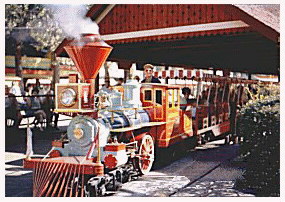
|

|
Miniature Train
20-0s This is how the train looks now after a complete overhaul. (Photo: Ken Jones Collection) |
Also in the park in the 1960s were an Eyerly "Roll-O-Plane", a kiddie coaster, and a Bartlett/Herschell "Moon Rocket" called simply "Rocket". 1968 ads mention "Space Whirl", Jungle Land, a new "Spider", and a Wax Museum. The latter was located under the dance hall.
Evidence of the 1960s kiddie coaster has surfaced. Lake Ontario Park has a used Shiff kiddie coaster which was apparently installed in that park in 1977. It supposedly came from Crystal Beach. A Herschell "Little Dipper" was in the park's closing inventory, so perhaps the Schiff unit was sold in 1976 and replaced by the Herschell model. The Schiff unit might have been in the park as early as post World War II, but no firm date is known at this time.
Ira Smith of Thornhill, Ontario recalls the kiddie coaster. He says: I remember it vividly. It was located immediately upon entering the park through the main entrance off of Erie Road. From the station platform, the ride basically did an oval, with a gentle rising and lowering of the track. I can't remember for sure, but it had four or five cars on the train, and each car held two or three children. They did two or three times around the track for your ride. The last time I was in the park was 1968-69 and it was still there. My earliest recollection of the ride would be 1956." Ira's description sounds like the Schiff model.
Continuing with the 1960s, an accident on The "Giant" caused one man to lose an eye when he leaned too far out of a car and caught his head on a support post. Despite being dragged out of the car and falling to a cross brace, he was rescued and suffered no other major injuries, except for his eye.
Rides in the park during this decade were a "Rock-O-Plane" (Eyerly) near The "Giant", a "Zugsptiz" ("Himalaya"-type of ride), a "Swiss Bobs" (Chance ?), and The "Airborne" which was an English version of a Hrubetz "Paratrooper". It was located in front of The "Scrambler" and for a time, in front of The "Comet" where a "Lightning Bug" had once sat. Also, a Chance "Sky Diver" appeared sometime in the late 60s or early 70s, but was gone by the mid 70s.
|
The Ballroom Midway Entrance circa 1960s or 70s 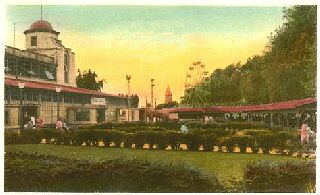 |
This undated postcard view is likely 1960s or 70s. It shows the covered walkway at Center & Center Right as viewed from ground level. This leads to the ferry dock at Center Left, which, in this image, is hidden from view by the ballroom. The ballroom entrance from the midway is at Center Left. An Eli Bridge ferris wheel may be seen at Center. |
| The turret seen to the left of it appears to be for The Magic Carpet/Palace, but that is not the correct location. The Magic Carpet/Palace lies behind the viewer. This turret is seen in photos from the 1940s and perhaps is for one of the hotels. |
A submission from Kim Palios of Grimsby, Ontario tells that when James Mitchell retired, he sold his home and concessions to Kim's grandfather, John Bonifacio. John then ran them under the name "J.B. Concessions". These included "Copper Penny Pitch", "Hoola Hoop", "Cat Knock Down" and a Rifle Range. Later his son, Rudy, joined John. During the final years of the park, they also ran the Bingo
Kim relates: "Three years ago (2007) we bought a cottage in Crystal Beach and I'm really happy to be `home'. There have been changes for sure, but I still `see' the yellow coaster when I turn the corner at Erie and Ridgeway Road, as well as the vision of The `Comet' over the lake when standing on the beach!"
In 1972 George Hall died at 88. He was still president at the time. Many rides were brought in to the park during this period as concessions. By 1974 Conklin Shows had an "Arctic Cat" (Chance "Toboggan"), a German Carousel, "Flitzer" (Zierer?), "Formula 5", and "Rotor" (Chance) rides, while another concessionaire, Dwayne Steck, provided "Hurricane" (Hrubetz), a "Monster" (Eyerly) and "Holiday Bounce". The latter may have only been in the park for the 1975 season.
A 1974 directory source says that the games and rides area during this time was called "The Million Dollar Midway". It was a paved and landscaped expanse over 1.5 kilometres long. Picnic facilities accommodated 5,000 and included seven new picnic shelters. Also mentioned were the athletic fields, ballroom & orchestras, beach, fireworks, miniature golf, picnic facilities, a pony track, roller rink, and a slot-car race track. Another attraction was "Fantasyland" underneath the ballroom.
Although attendance was estimated at 400,000, it continued to languish and in 1974 a fire severely damaged the dance hall, with the half million dollars it took to refurbish it cutting further into profits. Another $250,000 was spent for the 1975 season to update facilities that had not been damaged by the fire. In order to boost patronage, beer and wine were served for the first time in the park's history at The Big Top Restaurant, which had been built in the newly restored dance hall. Also new that year was the Cafe International Restaurant and a concession from Buena Vista, a Walt Disney company. It was a Wild West-themed, MacGlashaw laser-beam shooting gallery.
More rides were added for 1975, including a "Chair-O-Plane" (Sartori 56-seat model), kiddie bumper cars (Soli ?), kiddie Glass House, a Chance "Twister", and a Mack (vehicle) Carousel. The latter would be bought by Maple Leaf Village Amusement Park after Crystal beach closed in 1989.
An accident marred the season when just before 10 PM on June 23rd, a 26-year old man was thrown from the rear car of the "Comet" as it rounded a curve. Reports say the lap bar was working correctly and one account says the victim had been standing at the time of the ejection. It is the only known fatality on this ride.
In 1976 a pay-one-price policy was also introduced as another incentive, so that patrons could either pay a $1 admission charge (which was the first time a grounds admission had ever been charged), and then buy ride tickets or purchase the $5.50 POP (Pay One Price ticket) that allowed unlimited rides all day long. (The "Comet" roller coaster was excepted from the POP - it cost an extra 25 cents a trip.) New for 1976 were a boat ride and a "Lady Bug" (Eyerly 1978 ?); plus the park spent $750,000 for a "Cobug" (Ventura), "Pirates Fun House", and a "Swamp Buggy" (Pohl), all from the closed Pirate's World in Florida. Also advertised as new that year were "Flying Bobs" (this may have been a concession as one would be advertised as new to the park only 4 years later), "Tele-Combat", a Swinging Ride, "Pirate's Voyage" (same as above ?), and a Hrubetz "Tip Top". This was apparently a used ride dating from 1966 and likely replaced the similar "Holiday Bounce".
|
Ride Token 1970s 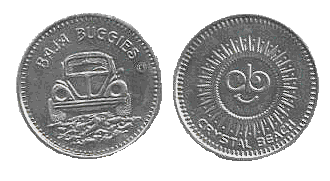
|
| Here are views of each side of a park ride token. This was for the Baja Buggy, which was likely the Pohl "Swamp Buggy". |
For 1977, The "Texas Revolver" (Larson "Super Loops") debuted at an extra 25 cents. Also new was a "Cinema 180" (Hollingsworth) which used a 70mm image projected on the interior of a domed tent. Other ads proclaimed The "Jolly Roger", "Giant Auto Scooter", "Monster" (Eyerly), "Tilt-O-Whirl" (Sellner), and "Space Screamer". I suspect this may have been an indoor "Scrambler" (Eli) with lighting effects. That same year saw The "Comet" double its extra charge to 50 cents.
1977 was also the season of another accident. A 28-year old woman and two children were hurt when a car on an un-named ride rolled back down a ramp. The safety bar remained closed and kept the occupants inside, but they all received back injuries and the woman, broken bones and a head cut.
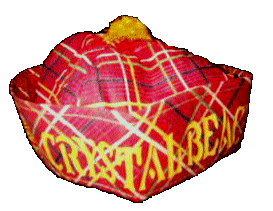 In 1978 the POP admission was increased to $6.00. The "Super Duper
Mountain" water slides were put in where a rock garden had been. This
garden had consisted of an elevated concrete terrace with stairways,
park benches, and thousands of flowers. It had been located near the
beach and ferry dock. The slides, also known as "Crown Mountain",
consisted of three 116-metre adult slides and one 27-metre kiddie
slide dropping through an 18-metre height difference. The intertwining
slides were built on a landscaped hillside with wooden stairs
returning riders to the top.
In 1978 the POP admission was increased to $6.00. The "Super Duper
Mountain" water slides were put in where a rock garden had been. This
garden had consisted of an elevated concrete terrace with stairways,
park benches, and thousands of flowers. It had been located near the
beach and ferry dock. The slides, also known as "Crown Mountain",
consisted of three 116-metre adult slides and one 27-metre kiddie
slide dropping through an 18-metre height difference. The intertwining
slides were built on a landscaped hillside with wooden stairs
returning riders to the top.
Other rides mentioned that year were "Antique Cars" (Bruchsal), "Auto Skooter" (2 models: 16 and 28 cars), The "Comet", "Flitzer" (Zierer ?), a Ferris Wheel (Eli 16), "Flying Coaster" (Aeroaffiliates - gasoline model), "Flying Swings', "Giant" coaster, "Hey Day", Jolly Roger", "Laff In The Dark", Merry-Go-Round (PTC), "Monster" Eyerly), "Scrambler" (Eli, Indoor), a Sky Ride (Hopkins), Tilt-A-Whirl" (Sellner), "Texas Revolver" (Larson), "Tip Top" Hrubetz), a Miniature Train (Chance/Huntington), "Water Skooter" (Herschell/Ward), and The "Wild Mouse" (Zierer), plus 9 Children's Rides.
Jim Abbate of Chicago says: "I remember riding the old "Wild Mouse", "Hey Day", "Flitzer", "Texas Revolver" and the old mill ride. The tunnels were dark and dank and the effects had chicken-wire in front of them. It was wonderful; and yes, the park's entrance had two `Looper' chairs hanging from it.'
Bill Pfeifer of Rochester, New York remembers The "Flying Coaster". He says it was there in 1977 and was located near The "Water Skooter".
The "Texas Revolver" was supposedly sold sometime in the early 1980s. Belmont Park bought a ride they named "Bouche de Texas" ("Texas Mouth") from Crystal Beach.
|
Sky Ride
1980s This postcard view shows the cables and cars of The Sky Ride. It ran from near the Comet entrance to the top level of the ferry pier, out of frame to the right rear. |
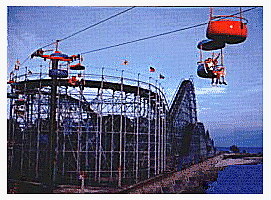
|
|
The Comet's lift and first drop are seen
(center right), going away from you. At
this end is the second turn-around.
|
Other attractions were a "Cinema 180" (Hollingsworth), The "Magic Palace", (Funhouse), and Miniature Golf. Food outlets included 2 restaurants and 10 food stands. The "Antique Cars" took the place of the old "Scenic Canal Ride". A lighthouse prop for that ride remained after the cars were installed and in fact was still there at park closing in 1989.
Attendance Increases - Disaster Looms
1980 saw attendance soar to 500,000, which supposedly was the best year ever for the park. A Chance "Flying Bobs" was put in. Some version of The "Bobs" had been on the midway since the late 1960s, the first coming from Allan Herschell's factory. Also installed in 1980 were a Huss "Pirate Ship" and a "Musik Express". The latter was to have been in the park in 1979 but was delayed due to a strike at the manufacturer's plant.
In 1982 The "Saw Mill River" Flume Ride by O. D. Hopkins was put in at a cost of $1.5 million and a July 19th publicity stunt had Mike & Celia Horwood ride The "Comet" through a pile of shaving cream at the bottom of one of the drops. This was shown on the CTV (Canadian Television Network) show "Thrill of a Lifetime". During this decade other attractions, including some to appeal to children were put in, but all to not much avail - attendance was weakening.
By 1983, with competition from Darien Lake, Canada's Wonderland which had opened two years before, and from MarineLand which had just installed a huge world record-breaking roller coaster ("Dragon Mountain"), plus high interest rates on loans and some poor weather, the park approached bankruptcy. It became the property of The Canadian Imperial Bank of Commerce (CIBC) after being forced into receivership, with Peat Marwick of Toronto being appointed the park's agent.
Music supporter/promoter Ramsi (born Ismar) P. Tick, who owned the Q-R-S Music Rolls Company that made player pianos and their rolls, stepped in and arranged with the CIBC to manage the park for the 1983 season with a possible option to buy. Although an American, Tick lived in a large home at Windmill Point in Ontario but still worked in his native Buffalo, New York. He said he wanted to buy the park that had belonged in part, and eventually in whole, to the Hall family of Buffalo starting in 1924.
Admission fees were $1 grounds and increased to $8.95 for the adult POP with a reduction after 5 PM to $4.95. Special rates were given to children and seniors. Peace Bridge tolls were rebated and a ferry was re-instated from Buffalo for Thursdays at a cost of $8 U.S. per adult (then about $11.20 Canadian) that landed at a refurbished pier. Mr. Tick planned to renovate the dance hall and the park's picnic area with trees & flowers to create more shade, plus add new bingo and miniature golf attractions, but it appears these were never done.
Kim Palios contributes that the Bonifacios joined with the Hall family and Ramsi Tick to try to save the park around this time. Early in 1984, after Canadian government approval, the park was sold to a group of American investors (of which Ramsi Tick was not one), under the name of "Crystal Beach Park Limited". One of the partners though, was Ed Hall, whose family had long been associated with the park. After these others bought Crystal Beach, Tick went on to become Community Relations Director of nearby Fantasy Island Amusement Park on Grand Island.
The new owners would spend over $2 million during the next three seasons. This included replacing the roof on The "Laff In the Dark" and refurbishing the dance hall with a new stage & dance floor while removing the restaurant and "Jolly Roger" that occupied some of the dance space. It reopened July 6th. Added to the park were a new ferris wheel, Abino Bay cruises, para-sailing, sailboating, and windsurfing. The Cinema 180 (Hollingsworth) was converted to a teen video area with a dance floor and screen, plus live bands on Friday nights. To cover this, the POP was increased to $11.90, with general grounds admission at $2. The American Coaster Enthusiasts held their convention at the park on July 13th, part of which included exclusive ride sessions on The "Giant" and "Comet".
A Sad Loss
Another part of that new money came from the sale of the park's 1906 Philadelphia Toboggan Company carousel #12. It was auctioned off piece by piece in December 1984 with bidders from 12 countries participating. The sale netted nearly half a million dollars U.S. A very unhappy end for such a valuable antique. It was replaced with a Herschell carousel bought at an auction. Dates of its manufacture vary, with one source saying 1940 but Norton Auctioneers pegged it as 1956. It's possible with the flak the park got over selling the antique carousel, that they may have exaggerated the actual manufacturing date of this replacement. Regardless, the additional funds allowed renovations and general improvements to the park for 1985 plus some additional attractions to be purchased, such as the larger ferris wheel (Eli No. 5), and a "Ball Crawl" (Wafabco).
To bolster business, the park's most popular ride, The "Comet", had the first two cars on two of its three trains turned around backwards in 1985. They also installed a nurse in the station in case anyone got sick, but that was mainly a publicity gimmick reminiscent of the old "Cyclone" days. POP was increased to $13.30 that year.
Jared Ruston, of Port Colborne, Ontario, submits that around this season a "Gravitron" was placed near The "Comet". He remembers the sliding platforms and loud music. He associates this ride with the season the "Comet" cars were turned around, but also feels it could have been as late as 1987 that The "Gravitron" came to the park. Since it's not in the closing inventory, this would have most likely been a concession.
1986 saw the installation of a "Galaxy" roller coaster. This ride from SDC of Italy, was a compact steel coaster, 14 metres high, running eight 4-passenger cars. Since this too, was not on the closing inventory in 1989, I suspect this may have been a concession. Sources say it was only in the park for one season, which is another clue towards that conclusion.
For 1987, a new club opened called "Schooners Beach Club". It was right next to the beach at the park in the old bath house, featured a nautical theme, served alcohol with food, and was open from 11 AM till 2 AM daily. Rowdy patrons leaving this club would be a factor in the demise of the park. Neighbours complained of the noise.
Jim Abbate of Chicago ran into this problem while visiting there May 28, 1988. He was with the National Amusement Park Historical Society / Western New York Coaster Club convention. They were attending the park to celebrate its 100th anniversary and the 40th anniversary of The "Comet". He explains: " Late at night, after the park closed to the general public, we had exclusive ride-time. It was all lights out in the park. The very last ride was wild! Management ran both trains on the track, one about 30 seconds after the other - and with no lap bars. It was insane. When we were leaving the park afterwards, several of us Chicagoans almost brawled with a bunch of drunken locals. Crazy! What a 100th anniversary memory."
The ride added in 1987 was a "Rotor" (Chance ? SDC ?) which placed riders in a round spinning room that pinned them to the wall, allowing the floor to drop away while riders remained. Since this was also not on the closing inventory, it likely was a concession. Other improvements were announced but there is no word as to whether they were ever implemented.
Unfortunately an accident that year put a downward tone on events. The "Laff in the Dark" had an electrical failure that sent sparks shooting up to the ceiling and caused one car to stop, allowing a second car to collide with it. The occupants of both cars escaped through emergency doors. Alerted by this and smoke pouring out of the building, the operator turned on work lights and evacuated the remaining riders. No one was injured.
Also in 1987, a new ferry service was about to happen. It was through the efforts of Ramsi Tick, who did not want to let go of his Crystal Beach boyhood memories that The Lake Erie Boat Cruise Corporation came into being. He wanted to have vintage ferryboat service from Buffalo for service to Canada. The "Block Island Sound Boat", a 1920s 685-passenger ferryboat, was bought, refurbished and put into service in 1988. Renamed The "Americana" in tribute to the Crystal Beach ferry of the past, it ran aground twice in the summer of 1988, causing the cruise company to lose half of its potential revenue.
Closure
By June of 1989, Tick was forced to seek protection from creditors, but the ferry continued on its daily schedule. Even when Crystal Beach closed in 1989, Tick felt there would still be a demand for the Buffalo-to-Canada service. However, by August 1990 it was clear that the company would never make money and it was dissolved by its creditors. The "Americana" was sold in 1991 to a Caribbean-based company. Tick died October 31, 2000 at age 75.
In 1989 the park changed hands with a partial buy-out and infusion of new investors. These new investors wished to build a marina, but did not want to put up the $15 - $20 million required to make the park competitive with amusement parks in that market. Poor weather and low attendance helped seal the park's fate. Even in the last season a go-kart track was installed (presumably as a concession, as the karts were not part of the closing inventory), but it was too little, too late, so the park ceased operations after the 1989 season.
Rides and buildings were auctioned off October 17th of that year with those unsold being demolished. Sadly, those not bought in whole included the "Laff in the Dark", "Giant" roller coaster and that beautiful ballroom - all of which were destroyed, save for a few mementos grabbed by collectors. "Laff in the Dark" was sold at the auction to Buffalo resident, David Arida for $8,000 (U.S.). He in turn sold "Laughing Sal" to Pete Szikura in New Jersey whereupon it was restored. She may now be seen in Lahaska, Pennsylvania at The Grand Carousel. No word on the rest of that ride, but presumably, it is separated now in various fans' collections.
The park occupied 15, 18, or 28 hectares by 1989. Sources do not agree. The discrepancy might involve the beach and parking lot area which may be counted in one figure and not in the others. Perhaps the park was 15, the parking lot was 3, and the beach another 10, although 10 hectares is an awfully large beach. A housing development now occupies the area.
Below is a list of the rides and attractions
the park had in the year of its 1989 closing:
Antique-Car Ride (Bruchsal) 6-Vehicle
Bumper Cars (Soli)
Carousel (1956) (Herschell) 3-Row, 40-Horse
Carousel (1975 ?) (Mack) Motor Vehicle Model
"Castle" (Ball Crawl) (Wafabco)
"Chair-O-Plane" (1976 75 ?) (Sartori)
"Cinema 180" (Hollingsworth)
"Comet" Roller Coaster (1948) (Schmeck/Allen/Mitchell)
Electric Boats (1979) (Ward) Same as the "Water Skooter"?
Ferris Wheel (12) (Eli)
"Flying Bobs" (1980) (Chance)
"Giant" Roller Coaster (1916) (Harton)
Go-Carts (?)
"Karousel" (Barbiera) 3-Row, 42-Animal
"Lady Bug" (1978 76 ?) (Everly)
"Laff In the Dark" (12-Car) (1936 Chambers)
(Shown in error as 1939.)
"Little Dipper" Roller Coaster (Herschell)
"Magic Palace" Walk-Thru
(Funhouse with mirrors, tilting
room, air blowers, tipping wall,
bar maze, and slide.)
Miniature Railway (Huntington/Chance)
"Monster" (Eyerly)
"Moon Walk" (1988) (Wafabco)
"Pirate Ship" (1978) (Huss) Installed in 1980
"Saw Mill River" Flume (1982) (Hopkins)
"Scrambler" (Eli)
"Skyfighter" (Herschell)
Sky Ride (Hopkins) (15 Gondolas)
"Super Duper" Water Slides (1978)
"Tilt-A-Whirl" (Sellner)
"Tip Top" (1966) (Hrubetz)
"Water Skooter" (Herschell/Ward) Bumper Boat Ride
(Same ride as the Electric Boats?)
Here are of some of the games the
park had at closing in 1989:
Basketball (Princeton)
"Bob's Space Racers" (7-Position "Whack-a-Mole")
"Boom Ball" (4 Unit)
Darts (Princeton)
"Derby Racer"
14-Gun Shooting Gallery (McGlashan)
Remote Control Tanks (6-Unit)
Plus, there was a large arcade called "Fun City"
with over 120 coin-operated games and amusements,
including many antique ones.
|
(*) For world's fair information, see the CEC's World's Fair sections
under Books, and at The Exhibition
Grounds on The CEC Midway.
My thanks to Paul Kassay (Mr. Crystal Beach) for much initial
information on this park and for a copy of his video tape "The Life
and Times of Crystal Beach". Paul worked at the park in the 1950s for
$35 a week making candy at Hall's Suckers!
For more on Crystal Beach Park, see: |
Return to the
Closed Canadian Parks Index